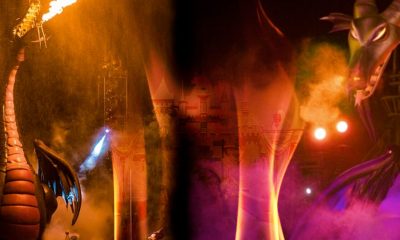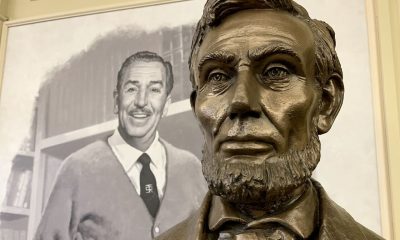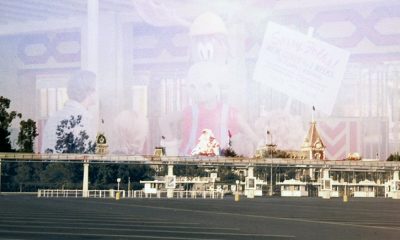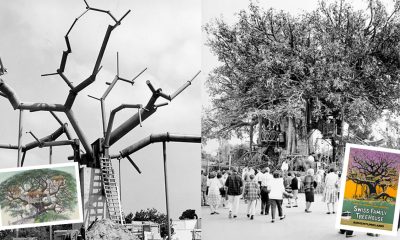History
Unpacking the History of the Pixar Place Hotel

Pixar Place Hotel, the newly unveiled 15-story tower at the Disneyland Resort, has been making waves in the Disney community. With its unique Pixar-themed design, it promises to be a favorite among visitors.
However, before we delve into this exciting addition to the Disneyland Resort, let’s take a look at the fascinating history of this remarkable hotel.
The Emergence of the Disneyland Hotel
To truly appreciate the story of the Pixar Place Hotel, we must turn back the clock to the early days of Disneyland. While Walt Disney had the visionary ideas and funding to create the iconic theme park, he faced a challenge when it came to providing accommodations for the park’s visitors. This is where his friend Jack Wrather enters the picture.
Jack Wrather, a fellow pioneer in the television industry, stepped in to assist Walt Disney in realizing his dream. Thanks to the success of the “Lassie” TV show produced by Wrather’s company, he had the financial means to build a hotel right across from Disneyland.
The result was the Disneyland Hotel, which opened its doors in October 1955. Interestingly, the early incarnation of this hotel had more of a motel feel than a hotel, with two-story buildings reminiscent of the roadside motels popular during the 1950s. The initial Disneyland Hotel consisted of modest structures that catered to visitors looking for affordable lodging close to the park. While the rooms were basic, it marked the beginning of something extraordinary.
The Evolution: From Emerald of Anaheim to Paradise Pier
As Disneyland’s popularity continued to soar, so did the demand for expansion and improved accommodations. In 1962, the addition of an 11-story tower transformed the Disneyland Hotel, marking a significant transition from a motel to a full-fledged hotel.
The addition of the 11-story tower elevated the Disneyland Hotel into a more prominent presence on the Anaheim skyline. At the time, it was the tallest structure in all of Orange County. The hotel’s prime location across from Disneyland made it an ideal choice for visitors. With the introduction of the monorail linking the park and the hotel, accessibility became even more convenient. Unique features like the Japanese-themed reflecting pools added to the hotel’s charm, reflecting a cultural influence that extended beyond Disney’s borders.
Japanese Tourism and Its Impact
During the 1960s and 1970s, Disneyland was attracting visitors from all corners of the world, including Japan. A significant number of Japanese tourists flocked to Anaheim to experience Walt Disney’s creation. To cater to this growing market, it wasn’t just the Disneyland Hotel that aimed to capture the attention of Japanese tourists. The Japanese Village in Buena Park, inspired by a similar attraction in Nara, Japan, was another significant spot.
These attractions sought to provide a taste of Japanese culture and hospitality, showcasing elements like tea ceremonies and beautiful ponds with rare carp and black swans. However, the Japanese Village closed its doors in 1975, likely due to the highly competitive nature of the Southern California tourist market.
The Emergence of the Emerald of Anaheim
With the surge in Japanese tourism, an opportunity arose—the construction of the Emerald of Anaheim, later known as the Disneyland Pacific Hotel. In May 1984, this 15-story hotel opened its doors.
What made the Emerald unique was its ownership. It was built not by The Walt Disney Company or the Oriental Land Company (which operated Tokyo Disneyland) but by the Tokyu Group. This group of Japanese businessmen already had a pair of hotels in Hawaii and saw potential in Anaheim’s proximity to Disneyland. Thus, they decided to embark on this new venture, specifically designed to cater to Japanese tourists looking to experience Southern California.
Financial Challenges and a Changing Landscape
The late 1980s brought about two significant financial crises in Japan—the crash of the NIKKEI stock market and the collapse of the Japanese real estate market. These crises had far-reaching effects, causing Japanese tourists to postpone or cancel their trips to the United States. As a result, reservations at the Emerald of Anaheim dwindled.
To adapt to these challenging times, the Tokyu Group merged the Emerald brand with its Pacific hotel chain, attempting to weather the storm. However, the financial turmoil took its toll on the Emerald, and changes were imminent.
The Transition to the Disneyland Pacific Hotel
In 1995, The Walt Disney Company took a significant step by purchasing the hotel formerly known as the Emerald of Anaheim for $35 million. This acquisition marked a change in the hotel’s fortunes. With Disney now in control, the hotel underwent a name change, becoming the Disneyland Pacific Hotel.
Transformation to Paradise Pier
The next phase of transformation occurred when Disney decided to rebrand the hotel as Paradise Pier Hotel. This decision aligned with Disney’s broader vision for the Disneyland Resort.
While the structural changes were limited, the hotel underwent a significant cosmetic makeover. Its exterior was painted to complement the color scheme of Paradise Pier, and wave-shaped crenellations adorned the rooftop, creating an illusion of seaside charm. This transformation was Disney’s attempt to seamlessly integrate the hotel into the Paradise Pier theme of Disney’s California Adventure Park.
Looking Beyond Paradise Pier: The Shift to Pixar Place
In 2018, Disneyland Resort rebranded Paradise Pier as Pixar Pier, a thematic area dedicated to celebrating the beloved characters and stories from Pixar Animation Studios. As a part of this transition, it became evident that the hotel formally known as the Disneyland Pacific Hotel could no longer maintain its Paradise Pier theme.
With Pixar Pier in full swing and two successful Pixar-themed hotels (Toy Story Hotels in Shanghai Disneyland and Tokyo Disneyland), Disney decided to embark on a new venture—a hotel that would celebrate the vast world of Pixar. The result is Pixar Place Hotel, a 15-story tower that embraces the characters and stories from multiple Pixar movies and shorts. This fully Pixar-themed hotel is a first of its kind in the United States.
The Future of Pixar Place and Disneyland Resort
As we look ahead to the future, the Disneyland Resort continues to evolve. The recent news of a proposed $1.9 billion expansion as part of the Disneyland Forward project indicates that the area surrounding Pixar Place is expected to see further changes. Disneyland’s rich history and innovative spirit continue to shape its destiny.
In conclusion, the history of the Pixar Place Hotel is a testament to the ever-changing landscape of Disneyland Resort. From its humble beginnings as the Disneyland Hotel to its transformation into the fully Pixar-themed Pixar Place Hotel, this establishment has undergone several iterations. As Disneyland Resort continues to grow and adapt, we can only imagine what exciting developments lie ahead for this iconic destination.
If you want to hear more stories about the History of the Pixar Place hotel, check our special edition of Disney Unpacked over on YouTube.
Stay tuned for more updates and developments as we continue to explore the fascinating world of Disney, one story at a time.
History
The Evolution and History of Mickey’s ToonTown

Disneyland in Anaheim, California, holds a special place in the hearts of Disney fans worldwide, I mean heck, it’s where the magic began after all. Over the years it’s become a place that people visit in search of memorable experiences. One fan favorite area of the park is Mickey’s Toontown, a unique land that lets guests step right into the colorful, “Toony” world of Disney animation. With the recent reimagining of the land and the introduction of Micky and Minnies Runaway Railway, have you ever wondered how this land came to be?
There is a fascinating backstory of how Mickey’s Toontown came into existence. It’s a tale of strategic vision, the influence of Disney executives, and a commitment to meeting the needs of Disney’s valued guests.
The Beginning: Mickey’s Birthdayland
The story of Mickey’s Toontown starts with Mickey’s Birthdayland at Walt Disney World’s Magic Kingdom. Opened in 1988 to celebrate Mickey Mouse’s 60th birthday, this temporary attraction was met with such overwhelming popularity that it inspired Disney executives to think bigger. The idea was to create a permanent, immersive land where guests could step into the animated world of Mickey Mouse and his friends.
In the early ’90s, Disneyland was in need of a refresh. Michael Eisner, the visionary leader of The Walt Disney Company at the time, had an audacious idea: create a brand-new land in Disneyland that would celebrate Disney characters in a whole new way. This was the birth of Mickey’s Toontown.
Initially, Disney’s creative minds toyed with various concepts, including the idea of crafting a 100-Acre Woods or a land inspired by the Muppets. However, the turning point came when they considered the success of “Who Framed Roger Rabbit.” This film’s popularity and the desire to capitalize on contemporary trends set the stage for Toontown’s creation.
From Concept to Reality: The Birth of Toontown
In 1993, Mickey’s Toontown opened its gates at Disneyland, marking the first time in Disney Park history where guests could experience a fully realized, three-dimensional world of animation. This new land was not just a collection of attractions but a living, breathing community where Disney characters “lived,” worked, and played.
Building Challenges: Innovative Solutions
The design of Mickey’s Toontown broke new ground in theme park aesthetics. Imagineers were tasked with bringing the two-dimensional world of cartoons into a three-dimensional space. This led to the creation of over 2000 custom-built props and structures that embodied the ‘squash and stretch’ principle of animation, giving Toontown its distinctiveness.
And then there was also the challenge of hiding the Team Disney Anaheim building, which bore a striking resemblance to a giant hotdog. The Imagineers had to think creatively, using balloon tests and imaginative landscaping to seamlessly integrate Toontown into the larger park.

Key Attractions: Bringing Animation to Life
Mickey’s Toontown featured several groundbreaking attractions. “Roger Rabbit’s Car Toon Spin,” inspired by the movie “Who Framed Roger Rabbit,” became a staple of Toontown, offering an innovative ride experience. Gadget’s Go-Coaster, though initially conceived as a Rescue Rangers-themed ride, became a hit with younger visitors, proving that innovative design could create memorable experiences for all ages.
Another crown jewel of Toontown is Mickey’s House, a walkthrough attraction that allowed guests to explore the home of Mickey Mouse himself. This attraction was more than just a house; it was a carefully crafted piece of Disney lore. The house was designed in the American Craftsman style, reflecting the era when Mickey would have theoretically purchased his first home in Hollywood. The attention to detail was meticulous, with over 2000 hand-crafted, custom-built props, ensuring that every corner of the house was brimming with character and charm. Interestingly, the design of Mickey’s House was inspired by a real home in Wichita Falls, making it a unique blend of real-world inspiration and Disney magic.
Mickey’s House also showcased Disney’s commitment to creating interactive and engaging experiences. Guests could make themselves at home, sitting in Mickey’s chair, listening to the radio, and exploring the many mementos and references to Mickey’s animated adventures throughout the years. This approach to attraction design – where storytelling and interactivity merged seamlessly – was a defining characteristic of ToonTown’s success.

Executive Decisions: Shaping ToonTown’s Unique Attractions
The development of Mickey’s Toontown wasn’t just about creative imagination; it was significantly influenced by strategic decisions from Disney executives. One notable input came from Jeffrey Katzenberg, who suggested incorporating a Rescue Rangers-themed ride. This idea was a reflection of the broader Disney strategy to integrate popular contemporary characters and themes into the park, ensuring that the attractions remained relevant and engaging for visitors.
In addition to Katzenberg’s influence, Frank Wells, the then-President of The Walt Disney Company, played a key role in the strategic launch of Toontown’s attractions. His decision to delay the opening of “Roger Rabbit’s Car Toon Spin” until a year after Toontown’s debut was a calculated move. It was designed to maintain public interest in the park by offering new experiences over time, thereby giving guests more reasons to return to Disneyland.
These executive decisions highlight the careful planning and foresight that went into making Toontown a dynamic and continuously appealing part of Disneyland. By integrating current trends and strategically planning the rollout of attractions, Disney executives ensured that Toontown would not only capture the hearts of visitors upon its opening but would continue to draw them back for new experiences in the years to follow.
Global Influence: Toontown’s Worldwide Appeal
The concept of Mickey’s Toontown resonated so strongly that it was replicated at Tokyo Disneyland and influenced elements in Disneyland Paris and Hong Kong Disneyland. Each park’s version of Toontown maintained the core essence of the original while adapting to its cultural and logistical environment.
Evolution and Reimagining: Toontown Today
As we approach the present day, Mickey’s Toontown has recently undergone a significant reimagining to welcome “Mickey & Minnie’s Runaway Railway” in 2023. This refurbishment aimed to enhance the land’s interactivity and appeal to a new generation of Disney fans, all while retaining the charm that has made ToonTown a beloved destination for nearly three decades.

Dive Deeper into ToonTown’s Story
Want to know more about Mickey’s Toontown and hear some fascinating behind-the-scenes stories, then check out the latest episode of Disney Unpacked on Patreon @JimHillMedia. In this episode, the main Imagineer who worked on the Toontown project shares lots of interesting stories and details that you can’t find anywhere else. It’s full of great information and fun facts, so be sure to give it a listen!
History
From Birthday Wishes to Toontown Dreams: How Toontown Came to Be

In the latest release of Episode 4 of Disney Unpacked, Len and I return, joined as always by Disney Imagineering legend, Jim Shull. This two-part episode covers all things Mickey’s Birthday Land and how it ultimately led to the inspiration behind Disneyland’s fan-favorite land, “Toontown”. But let’s not get ahead of ourselves here. It all starts in the early days at Disneyland.
Early Challenges in Meeting Mickey
Picture this: it’s the late 1970s and early 1980s, and you’re at Disneyland. You want to meet the one and only Mickey Mouse, but there’s no clear way to make it happen. You rely on Character Guides, those daily printed sheets that point you in Mickey’s general direction. But let’s be honest, it was like finding a needle in a haystack. Sometimes, you got lucky; other times, not so much.

Mickey’s Birthdayland: A Birthday Wish that Came True
Fast forward to the late 1980s. Disney World faced a big challenge. The Disney-MGM Studios Theme Park was under construction, with the company’s marketing machine in full swing, hyping up the opening of Walt Disney World’s third theme park, MGM Studios, in the Spring of 1989. This extensive marketing meant that many people were opting to postpone their family’s next trip to Walt Disney World until the following year. Walt Disney World needed something compelling to motivate guests to visit Florida in 1988, the year before Disney MGM Studios opened.
Enter stage left, Mickey’s Birthdayland. For the first time ever, an entire land was dedicated to a single character – and not just any character, but the mouse who started it all. Meeting Mickey was no longer a game of chance; it was practically guaranteed.

The Birth of Birthdayland: Creative Brilliance Meets Practicality
In this episode, we dissect the birth of Mickey’s Birthdayland, an initiative that went beyond celebrating a birthday. It was a calculated move, driven by guest feedback and a need to address issues dating back to 1971. Imagineers faced the monumental task of designing an experience that honored Mickey while efficiently managing the crowds. This required the perfect blend of creative flair and logistical prowess – a hallmark of Disney’s approach to theme park design.
Evolution: From Birthdayland to Toontown
The success of Mickey’s Birthdayland was a real game-changer, setting the stage for the birth of Toontown – an entire land that elevated character-centric areas to monumental new heights. Toontown wasn’t merely a spot to meet characters; it was an immersive experience that brought Disney animation to life. In the episode, we explore its innovative designs, playful architecture, and how every nook and cranny tells a story.

Impact on Disney Parks and Guests
Mickey’s Birthdayland and Toontown didn’t just reshape the physical landscape of Disney parks; they transformed the very essence of the guest experience. These lands introduced groundbreaking ways for visitors to connect with their beloved characters, making their Disney vacations even more unforgettable.
Beyond Attractions: A Cultural Influence
But the influence of these lands goes beyond mere attractions. Our episode delves into how Mickey’s Birthdayland and Toontown left an indelible mark on Disney’s culture, reflecting the company’s relentless dedication to innovation and guest satisfaction. It’s a journey into how a single idea can grow into a cherished cornerstone of the Disney Park experience.

Unwrapping the Full Story of Mickey’s Birthdayland
Our two-part episode of Disney Unpacked is available for your viewing pleasure on our Patreon page. And for those seeking a quicker Disney fix, we’ve got a condensed version waiting for you on our YouTube channel. Thank you for being a part of our Disney Unpacked community. Stay tuned for more episodes as we continue to “Unpack” the fascinating world of Disney, one story at a time.
History
31 Long-Gone Rides, Shows & Attractions at Disney-MGM (Hollywood Studios)
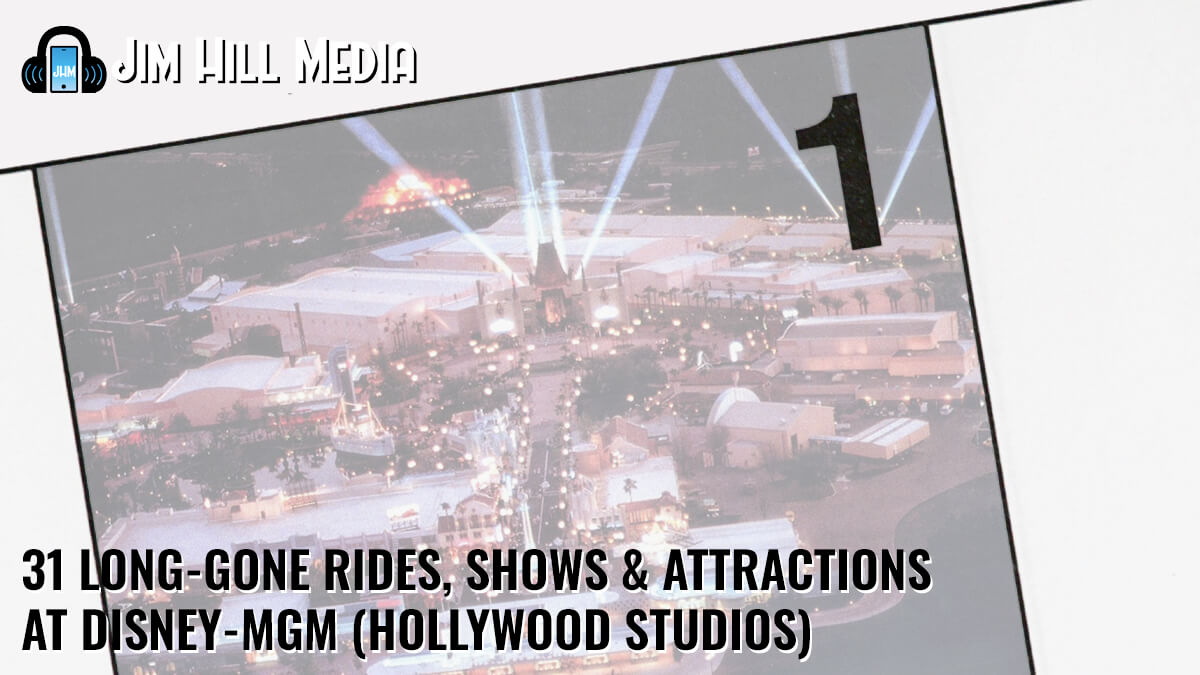
May 1, 1989 … It was 34 years ago that the Disney-MGM Studio theme park first opened its door. So many great attractions have come & gone over the past three decades that we thought that it would be fun to look back at a few of our favorites.
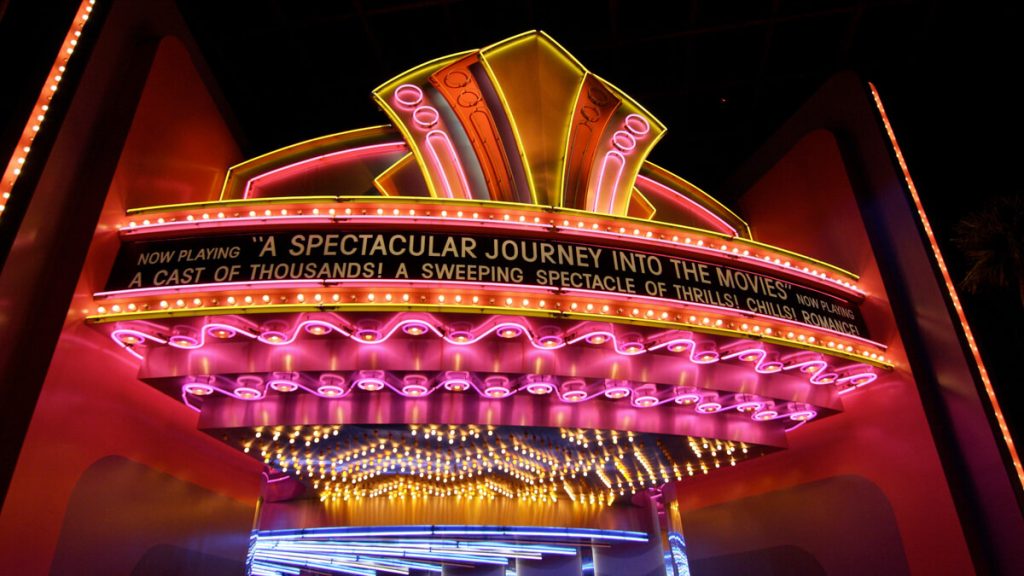
“The Great Movie Ride”
First up, it’s the Great Movie Ride. This was the thesis attraction for this entire park (much like Spaceship Earth is for Epcot), a celebration of all things cinema. The exterior of this 95,000 square foot show building was a faithful recreation of Hollywood’s iconic Chinese Theater. Once you climbed aboard your theater car, you were literally whisked over the rainbow to the Land of Oz (Watch out for the Wicked Witch of the West. Which was the most sophisticated Audio-Animatronic figure that WDI had ever produced. Circa 1989, I mean).
Did you know? … That the Great Movie Ride was originally supposed to have featured a scene built around “Ghostbusters” ? Sadly, Universal snagged the theme park rights ahead of Disney for that 1984 Columbia Pictures. But if the Imagineers had had their way, you’d have come face-to-face with the Stay Puft Marshmallow Man as Peter, Ray, Ego & Winston wielded their proton packs. Ah, what might have been …
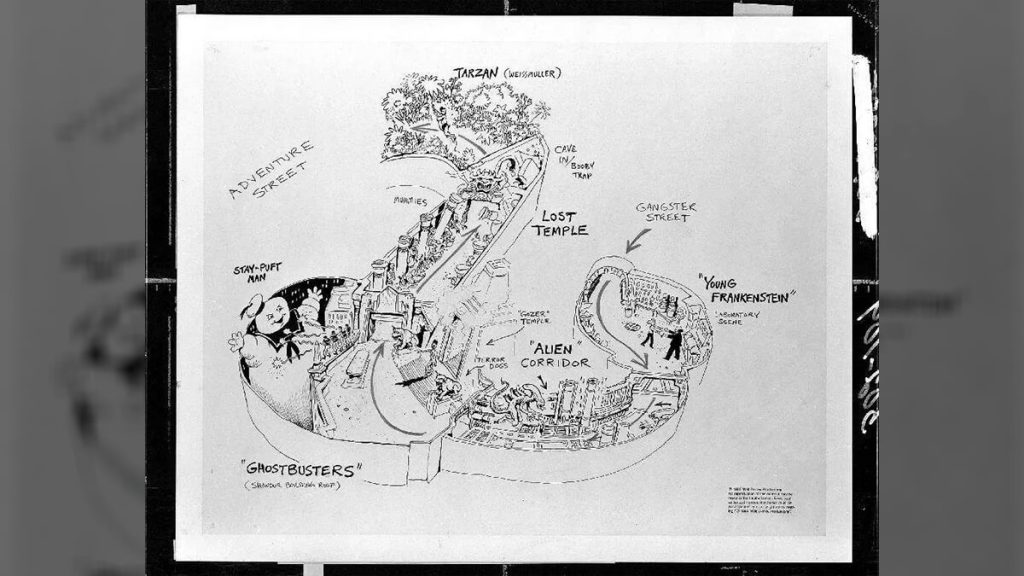
“Monster Sound Show”
How many of you recall the Monster Sound Show sponsored by Sony?
This Guest participation show (four members of the audience were recruited to recreate the various sound effects that were prominently featuring in a short film starring Chevy Chase & Martin Short) actually served a dual purpose. It was a way for Disney to showcase some of the amazing devices that its FX wizards had built over the past 60 years to then create those crazy sound effects featured in its full-length films & animated shorts. It also gave Disney-MGM at least one attraction that paid tribute (sort of) to horror films.

Sadly, “The Monster Sound Show” only ran at Disney-MGM from May of 1989 through July of 1997. After that, this attraction was rebranded as the “ABC Sound Show” (Which then tied this theme park show in with Disney’s August 1995 acquisition of ABC / Cap Cities).
“Studio Backlot Tour”
We continue with the Studio Backlot Tour. Which took many different forms during the over-25-years that this experience was available to Guests visiting the WDW Resort.
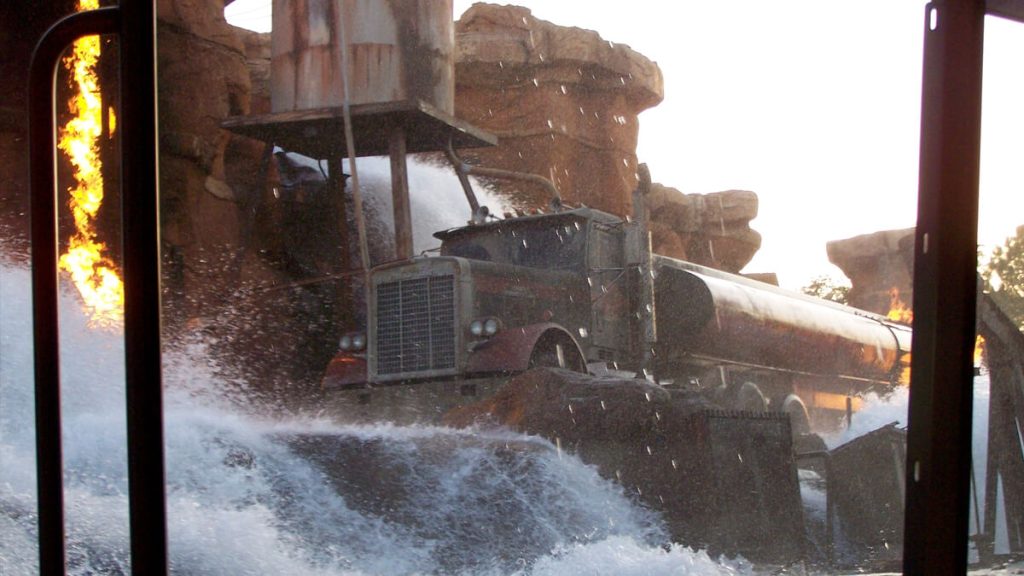
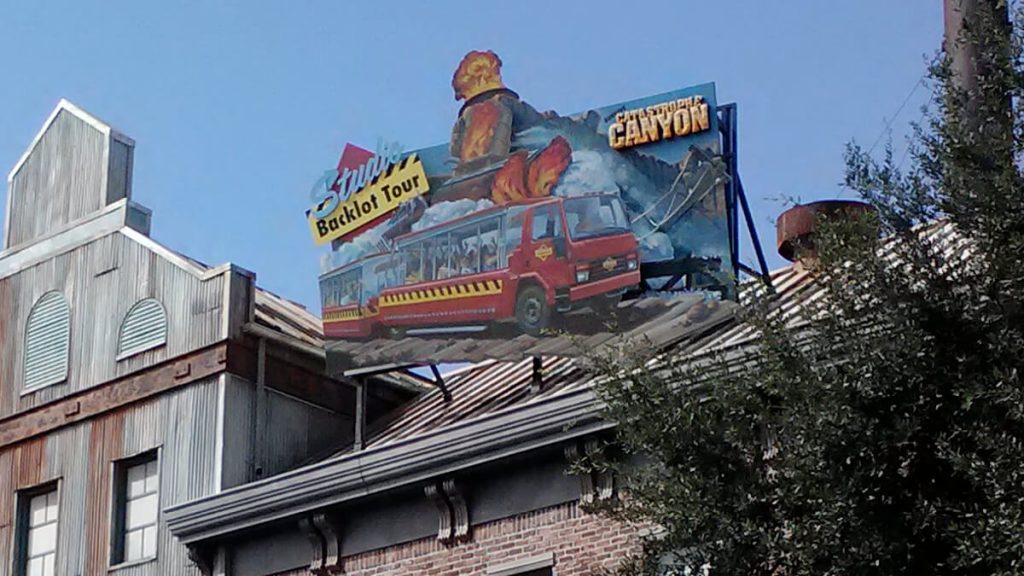
Early on, the Studio Backlot Tour had a rather rigid form. This nearly two-hour-long experience began with a tram ride through Residential Street (Where you could then see a recreation of the “Golden Girls” house) and then a thrilling detour through Catastrophe Canyon. Then Guests took a walking tour of the three state-of-the-art soundstages that Disney had just built in Florida.
When Guests complained about how long the original version of the Studio Backlot Tour was, Disney then turned this attraction into two separate experiences: a backstage tram ride and THEN a walking tour of its Florida soundstages. Both of these were discontinued in September of 2014 to make way for “Star Wars: Galaxy’s Edge.”
“The Magic of Disney Animation”
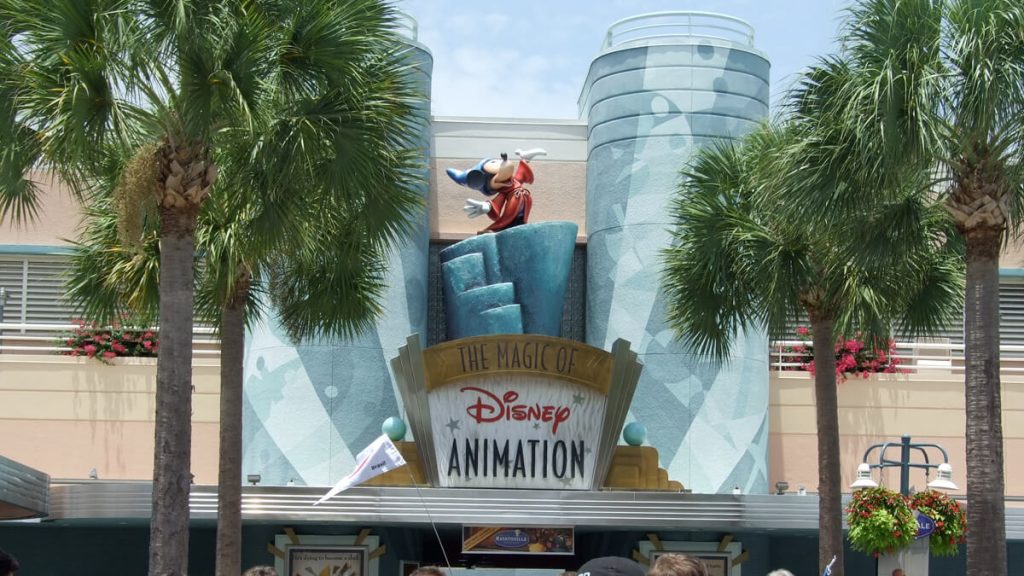
Our look at now-long-gone attractions at Disney-MGM (Now Disney’s Hollywood Studios) now continues with something of a heart-breaker. Which was the “Magic of Disney Animation” attraction, which was home to Disney Feature Animation – Florida from 1989 – 2003.
This was where Guests could visit the fish bowl (That’s what all of the artists & animators who actually work in the glassed-in portion of this walk-through attraction called this part of the tour) and peer down at work being done on upcoming animated features & shorts. Among the films that were primarily produced in Florida were “Mulan,” “Lilo & Stitch,” “Brother Bear” & “Roller Coaster Rabbit.”
Sadly, when Walt Disney Animation Studios decided in the early 2000s to shift over to producing CG films (Disney’s last two hand-drawn films – to date, anyway – were 2009’s “Princess & the Frog” and 2011’s “Winnie-the-Pooh”), the decision was made to shutter the Florida studio and lay off most of the staff who worked there. Many still consider this to be one of the stupidest decisions ever made by Mouse House executives.
“Super Star Television”
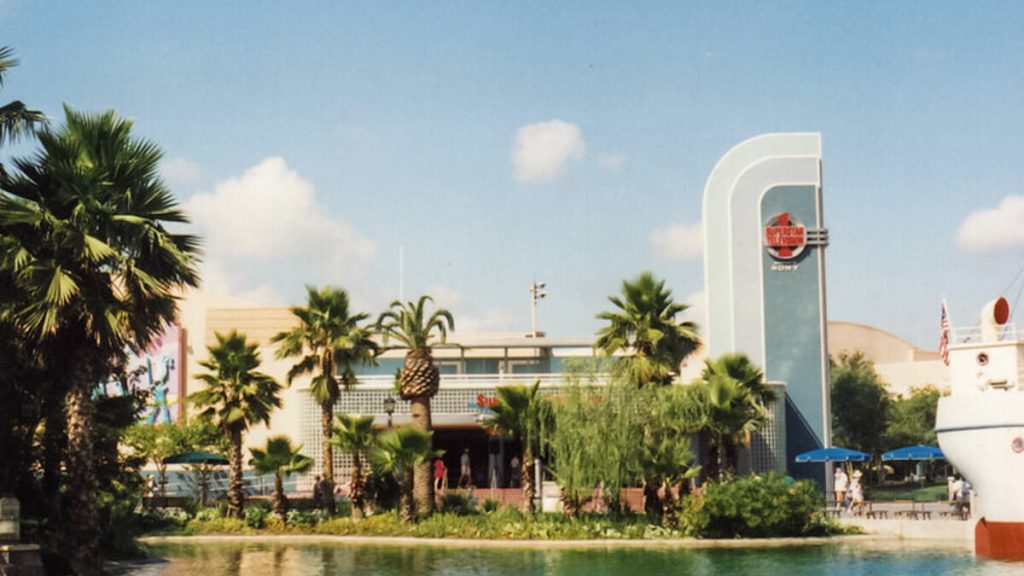
Let’s revisit SuperStar Television. This sponsored-by-Sony show gave upwards of 30 visitors to this theme park to make appearances in classic TV shows like “I Love Lucy,” “Bonaza” and “Gilligan’s Island.”
I myself got recruited to be part of a presentation of SuperStar Television. I was selected to be hit in the face with a pie by Curly Howard in a scene starring the Three Stooges. As I recall, I was dressed in a swallow-tailed tuxedo which Velcroed up the back. And the two lines that I had to say were “Dinner is served” (after which I got hit in the kisser with that pie) and then “Why you!” (After which I then tried to throw a pie at Moe but wound up hitting this high society lady instead).
Sadly, “SuperStar Television” was shut down in September of 1998 so that this centrally locate theater could then become a number of different attractions (among them “The American Idol Experience”).
“Soundstage Restaurant”
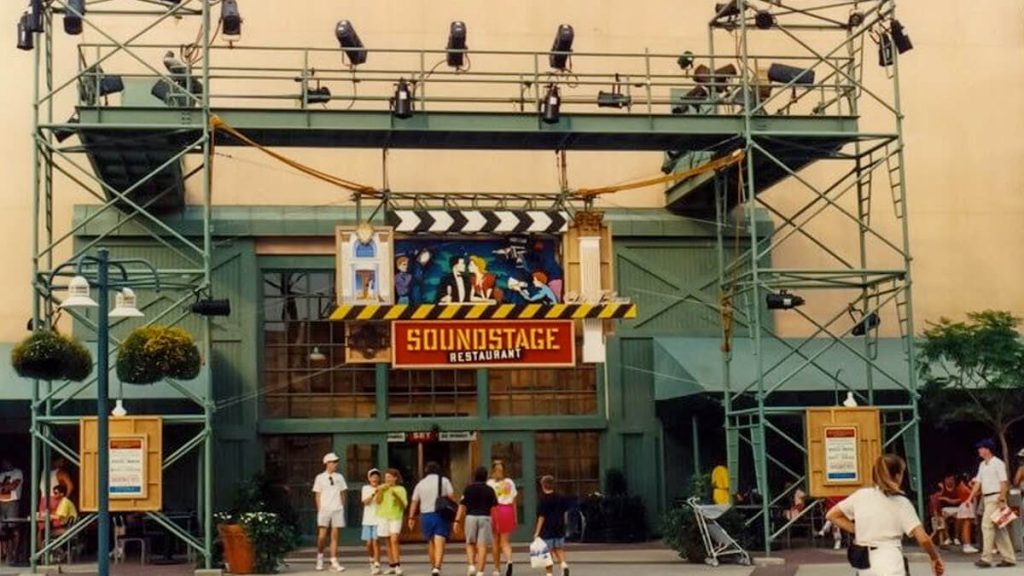
One of my favorite places to dine at this theme park back in the day was the Soundstage Restaurant. How many of you got to visit this quick service eatery right after Disney-MGM first opened? Back then, you could dine in a full-sized recreation of the lobby of NYC’s Plaza Hotel (This lavish set had originally been built for the 1988 Touchstone comedy, “Big Business.” And once production of this Bette Midler / Lily Tomlin comedy was complete, it was then shipped from California to Florida and installed just off this theme park’s Animation Courtyard area).
And speaking of animation … The dining room of the Soundstage Restaurant was redressed a number of times over the next 9 years to celebrate the most recent release from Walt Disney Animation Studios. Which meant – depending on which year you visited this quick service eatery – you could have dined in Belle’s Village or the Cave of Wonders from “Aladdin.”
Mind you, your parents may have a very different memory of the Soundstage Restaurant. Largely because – upstairs – was the Catwalk Bar. Which was a quick spot away from the noise & the heat that served adult beverages.
So let’s all raise a glass to the late, great Soundstage Restaurant. Which closed in November of 1998 to make way for the “Bear in the Big Blue House: Live On Stage” show.
“Here Come the Muppets” Stage Show
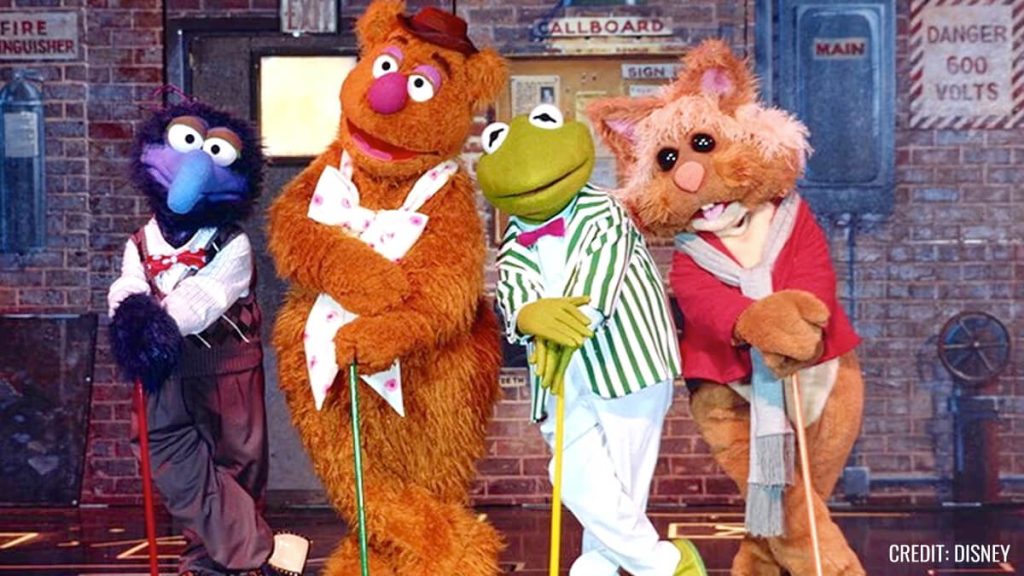
Our story starts in August of 1989 (just three months after this theme park first opened) with the announcement that The Walt Disney Company would acquiring The Jim Henson Company for $150 million. With the idea here being that the Muppets would then make their home at Disney-MGM and fill up this place with all sorts of crazy, one-of-a-kind attractions. Places like the Great Gonzo’s Pandemonium Pizza Parlor and the Swedish Chef’s TV Cooking School.
Mind you, those elaborate attractions (which were then going to be located inside of Muppet Studios, a brand-new land at Disney-MGM) were going to take a few years to design & construct. And – in the interim – Jim Henson personally worked with the Imagineers to quickly get a live stage show which featured the Muppets up out of the ground as quickly as possible.
“Here Come the Muppets” opened at Disney-MGM on May 25, 1990. Which was just nine months after Disney’s deal to acquire Henson had first been announced. Sadly, just 9 days prior to this show opening at the Studios, Jim Henson died of bacterial pneumonia. Which eventually derail Disney’s first attempt to acquire the Muppets.
How many of you remember “Here Come the Muppets” ? Which featured Doctor Teeth & the Electric Mayhem making their entrance in this show via a monorail that they first hijacked & then drove straight to the wall of that theater.
“Sorcery in the Sky” Fireworks Show
Let’s now discuss this theme park’s first nighttime show. Which was “Sorcery in the Sky.”
Don Dorsey – the talented gentleman who created “Laserphonic Fantasy” & then “IllumiNations” for EPCOT – really had his work cut for him when he was first handed the “Sorcery in the Sky” project. You have to remember that – back then – Disney-MGM was an active film & television production center as well as a working theme park. Which is a polite way of saying that – when the Imagineers first designed Disney-MGM – they weren’t actually planning on presenting a nightly fireworks display at the place.
So working with a tight schedule (WDW officials wanted “Sorcery in the Sky” up & running 13 months after Disney-MGM first opened) and an even tighter budget, Don did what he could. Which was craft a show that was kind of a camel. Half a celebration of classic Hollywood (featuring the music of memorable motion pictures like “The Wizard of Oz,” “Singin’ in the Rain” and “Close Encounters of the Third Kind”) and the other half to Disney’s 1940 release, “Fantasia.”
It’s the conclusion of “Sorcery in the Sky” that most people remember even today. That’s when – as an excerpt from Paul Dukas’ “The Sorcerer’s Apprentice” played – a 50-foot-tall inflatable version of Mickey Mouse slowly rose up on the rooftop of the Chinese Theater. And as “Sorcery in the Sky” reached its climax, sparks then shot out Mickey’s finger tip (which was pointed out towards Disney-MGM’s parking lot. As if this giant Mouse was saying “That’s where your car is. Now please get out.”)
“Sorcery in the Sky” (which was originally narrated by screen legend Vincent Price) ran at this theme park from May of 1998 – October of 1998. This nighttime fireworks display was discontinued when the Florida version of “Fantasmic!” debut in the Fall of that same year.
Dick Tracy in the “Dimond Double-Cross” Stage Show
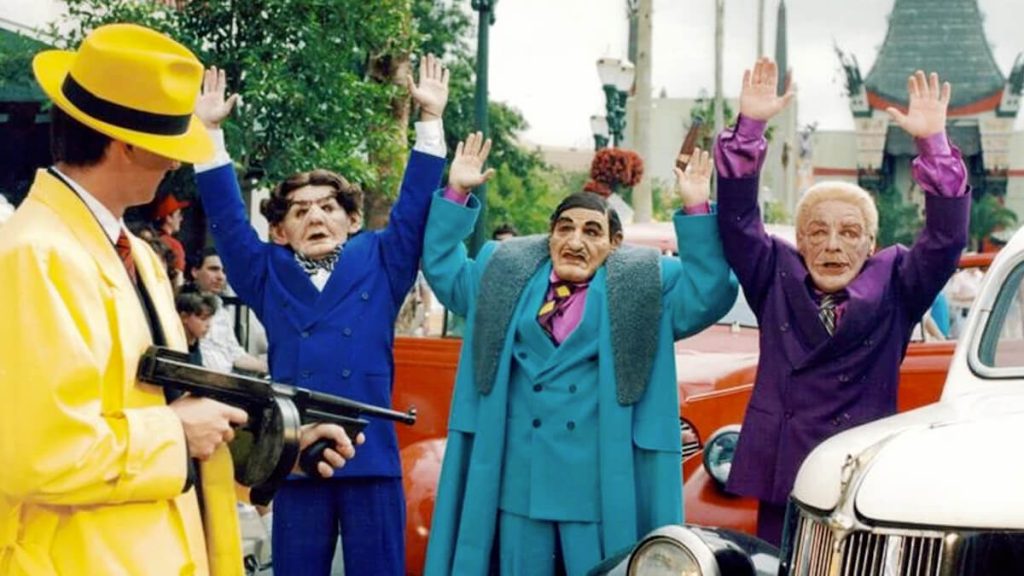
Let’s take a look at a piece of cross promotion at this theme park that then resulted in an intriguing stage show.
In the Spring of 1990, Walt Disney Studios was getting ready to release its answer to Tim Burton’s hugely successful “Batman” movie. And that was a feature film based on another comic book character, Dick Tracy. And since the Studios wanted the company’s theme parks to help promote this Warren Beatty, they were then tasked with creating some sort of Dick Tracy-themed stage show.
So director Robert Jess Roth & choreographer Matt West put their heads together and crafted a 28-minute-long musical comedy (which then used a few of the songs that legendary Broadway composer Stephen Sondheim had written for the “Dick Tracy” film) called “Diamond Double-Cross.”
Warren Beatty’s “Dick Tracy” movie quickly sank at the box office. But “Diamond Double-Cross” was hugely popular with theme park guests and ran for nine months at Disney-MGM’s old Theater of the Stars (Back when this Hollywood Bowl-inspired structure was still located next to that theme park’s Brown Derby Restaurant).
In fact, then-Disney president Michael Eisner was so impressed with what Roth & West had done when it came to translating “Dick Tracy” into a theme park show that – when the Company decided in 1993 that it was going to turn Disney’s animated hit, “Beauty & the Beast” into a Broadway musical – who did Michael recruit for this job? Robert & Matt.
Teenage Mutant Ninja Turtles appear on the Streets of America
As we continue our look back at long-gone rides, shows & attractions at Disney-MGM (Now Disney’s Hollywood Studios), let’s check out the Streets of America.
When this theme park first opened in May of 1989, the only way you could see this part of Disney-MGM (which – back then – was known as New York Street) was if you climbed aboard a tram and took the Backstage Studio Tour. By December of that same year, the Imagineers had realized that they needed to give visitors to WDW’s third theme park lots more elbow room. Which is when they decided to open New York Street (now known as the Streets of America) to foot traffic.
Of course, the problem with opening up all of this space at the very back of Disney-MGM was … Well, you now needed to give those Guests who actually hiked back there something to see & do other than poke around al those empty NYC-themed storefronts.
Luckily, in March of 1990, the very first “Teenage Mutant Ninja Turtles” was released to theaters. And this New Line Cinema movie did so well at the box office (It was the fourth highest grossing film of that year, just behind “Ghost,” “Pretty Woman” & “Home Alone”) that Disney moved quickly to acquire the theme park rights to these hugely popular characters.
Which is why – just three months after TMNT originally debuted at your local multiplex — Leonardo, Donatello, Michelangelo, and Raphael (along with April O’Neil) were making multiple appearances daily out on New York Street. How many of you remember how these characters used to first roll onstage aboard the Turtle Party Wagon, then do a brief martial arts demonstration while April sang the “Teenage Mutant Ninja Turtles” theme song? This all-too-brief show (we’re talking 4 minutes, tops) ended with Guests then getting the chance to get their picture taken with their favorite turtle.
Sadly, these “Heroes on a Half Shell” didn’t hang on all that long at Disney-MGM. By 1994, the Teenage Mutant Turtles were no longer doing meet-n-greets on the Streets of America. But a different character from New Line Cinema (one which Disney also licensed the theme park rights to) would soon begin greeting theme park guests. We’ll get to him in a future installment of this series.
“Muppets on Location: Day of Swine and Rose” Stage Show
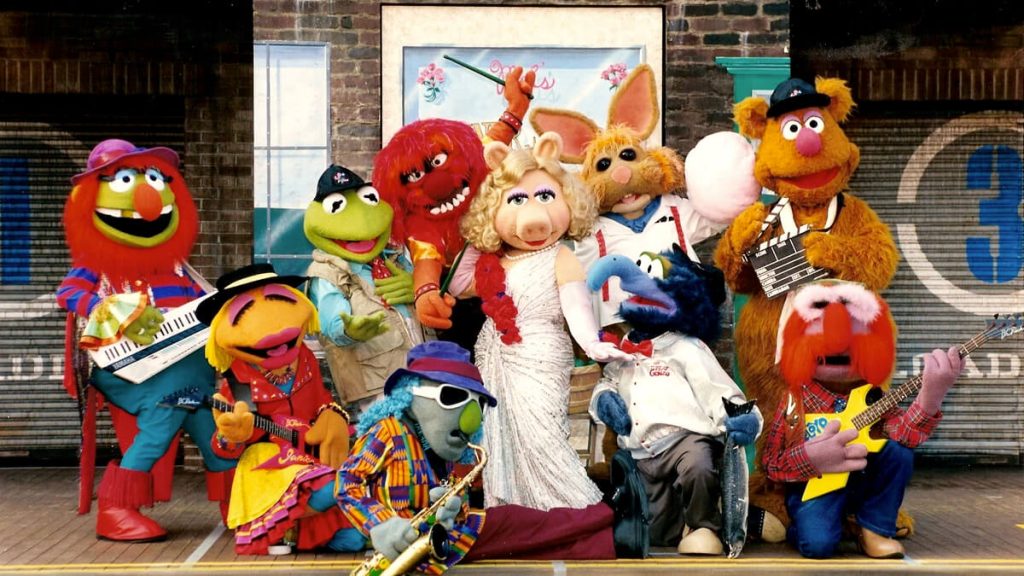
As we press ahead with our look at now-extinct rides, shows & attractions at Disney-MGM (Now Disney’s Hollywood Studios), it’s now time to talk about “Muppets on Location: Days of Swine and Roses.”
This outdoor presentation – which was presented as often as 5 times daily at the very back of Muppet Studios – was sort of a sequel to “Here Come the Muppets,” an indoor stage show we’ve previously discussed in this series.
And “Muppets on Location” … Well, its goal was to solve Guests’ No. 1 complaint about Disney-MGM’s “Here Come the Muppets” show. Which was “I want to get my picture taken with and/or collect the autograph of my favorite Muppet. How exactly do I do that?”
WDW’s Entertainment team came up with kind of an ingenious solution to this problem. They created this moment in the middle of this outdoor stage show where – as Doctor Teeth & the Electric Mayhem played an extended musical number – Kermit the Frog, Fozzie Bear, Miss Piggy, the Great Gonzo and Beanie would then move to pre-designated meet-n-greet spots at the edge of the “Muppets on Location” performance area and then interact with as many Guests as they possibly could in that short window of time.
It wasn’t a perfect system. Often Disney-MGM visitors would queue up to get their picture taken with their favorite Muppet character, only to then have Kermit & Co. suddenly rush back to the stage so that they could then take part in this show’s finale. Another aspect of “Muppets on Location” is that … Well, the Muppet walk-around characters at Disney-MGM wouldn’t sign Guests’ autograph books. They’d instead stamp them with a giant rubber stamp which then approximated what that Muppet character’s signature was supposed to look like.
“Muppets on Location: Days of Swine and Roses” didn’t run all that long. By 1994, Miss Piggy & pals had packed up and vacated this corner of Disney-MGM. Which – some 15 years later – then became home to a Phineas & Ferb-themed meet-n-greet.
One especially sad story associated with “Muppets on Location: Days of Swine & Roses” : This was the Disney-MGM show that Jim Henson was supposed to be recording dialogue for on May 16, 1990. Which was the day that this Disney Legend succumbed to bacterial pneumonia.
“Dinosaur Live!”
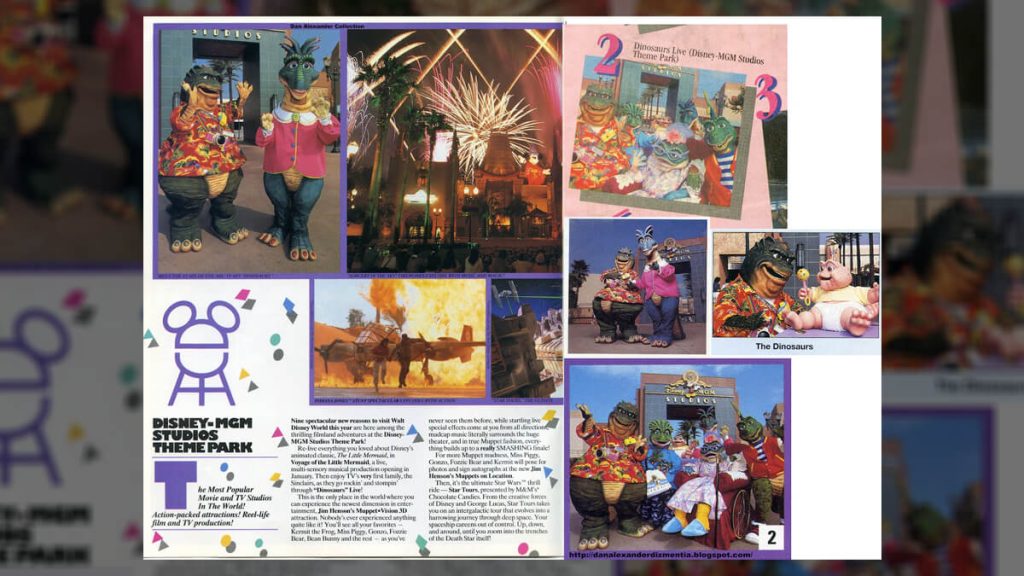
Let’s now check out a parade that was developed for this theme park which was originally supposed to celebrate the Muppets.
“The Magnificent Muppet All-Star Motorcade” was originally supposed to have begun rolling down Hollywood Boulevard the very same summer that “Jim Henson’s Muppet Vision 3D” opened at Disney-MGM. Unfortunately after Jim’s untimely passing in May of 1990, the Henson family decided that it no longer wanted to sell the Muppets to Disney and broke off negotiations with the Mouse in December of that same year.
This made things complicated for the folks who worked in Entertainment at Walt Disney World, given that they had already begun construction on the various parade floats that were to be featured in “The Magnificent Muppet All-Star Motorcade.” And given the terms of the settlement that Disney’s lawyers had hashed out with Henson’s attorneys in the Spring of 1991 … Well, Miss Piggy & pals now couldn’t appear on these already-largely-completed parade floats.
So what do you in a situation like this? You improvise. In April of 1991, “Dinosaurs” debuted on ABC. This sitcom was produced by Michael Jacobs Productions & Jim Henson Television in association with Walt Disney Television. Consequently, Disney’s legal agreement with Henson which kept Kermit & Co. off of the floats that had been built for “The Magnificent Muppet All-Star Motorcade” didn’t apply in this situation.
Which is why – from September of 1991 thru August of 1992 – the Sinclair family made daily appearances at Disney-MGM. Riding on parade floats that had previously been designed for the Great Gonzo as well as Doctor Teeth & the Electric Mayhem. Which then allowed WDW Entertainment to write off all of the money that they’d already spent on the design & development of “The Magnificent Muppet All-Star Motorcade.”
“Honey, I Shrunk the Kids: Movie Set Adventure”
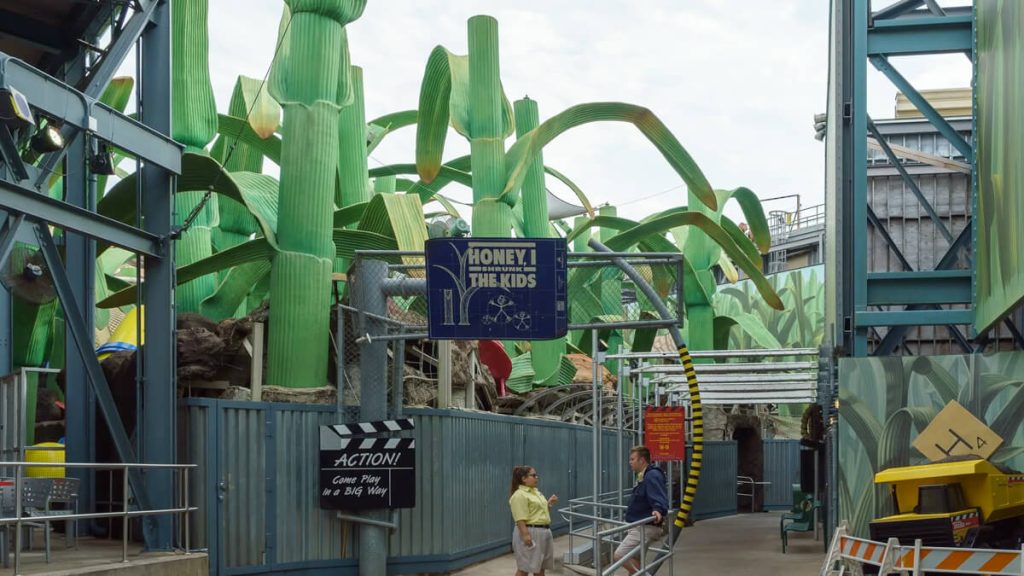
It’s time to check out a playground that was added to this theme park’s Street of America area on the heels of the June 1989 release of “Honey, I Shrunk the Kids.”
This Joe Johnston film (which was released to theaters just 8 weeks after Disney-MGM first opened to the public) was the surprise hit of the Summer of 1989. “Honey” actually wound up being the fifth highest grossing film of that year, just behind “Batman,” “Indiana Jones and the Last Crusade,” “Lethal Weapon 2” and “Rain Man.”
Walt Disney Pictures immediately announced plans to produce a slew of sequels (They even went as far as to copyright a number of possible titles for these films in the late Summer of 1989. These included “Honey, I Sent the Kids to the Moon,” “Honey, I Switched Brains with the Dog,” and “Honey, I Made the Kids Invisible”). And on the theme park side of things, the Imagineers rushed to get a “Honey” -themed playground in the works for Disney-MGM Studios.
Which wasn’t as easy as you might think. After, Florida is hurricane country. So when you’re talking about installing 30-foot-tall blades of grasses, you then have to make sure that this structures are then properly anchored / can then stand up to 300 MPH.
Then there’s the issue of making sure that when little kids come sliding down off of that giant piece of film that’s then sticking out of that oversized Kodak cannister (And – just in case you’re wondering – Kodak got that kind of prominent product placement inside of this playground because they contributed to the cost of building “Honey, I Shrunk the Kids: Movie Set Adventure”) and then not hurting themselves when they hit the ground.
“How’d the Imagineers manage that?,” you ask. The entire surface of this 11,000 square foot playground was covered with a material called Playdeck. Which was made up of ground-up truck tires.
Sadly, “Honey, I Shrunk the Kids: Movie Set Adventure” closed in May of 2016 to make room for another movie set adventure. Maybe you’ve heard of it? “Star Wars: Galaxy’s Edge” ?
“Voyage of the Little Mermaid” stage show

Let’s talk about a stage show at this theme park that had some surprising legs. And that’s “Voyage of the Little Mermaid.”
To explain: In show biz parlance, when you say that a show has legs … Well, that then means this show has settled in for a surprisingly long run at the theater it’s being presented at. And that’s certainly what happened with the “Voyage of the Little Mermaid” show at Disney-MGM. It opened in the Animation Courtyard Theater back on January 7, 1992. And to be honest, if it hadn’t been for the pandemic (which forced all of Walt Disney World to shut down for almost three months in early 2020), the “Voyage of the Little Mermaid” would probably be running at that theme park even today.
Mind you, this 17-minute-long presentation was pretty much a Reader’s Digest version of this Academy Award-winning animated feature. But “Voyage of the Little Mermaid” packed an awful lot of 1990s era FX & pizzaz in that very short running time. There were lasers (to simulate the waves in the ocean as we journeyed “Under the Sea”), black light puppets, and bubbles galore. And who can forget that 12 foot-tall, 10 foot-wide Ursula puppet which sang “Poor Unfortunate Soul” ?
What was really intriguing about the “Voyage of the Little Mermaid” stage show is … Well, WDW’s Entertainment team deliberately designed this show to only run for 18 months (Given that the stage show which preceded “Mermaid” in the Animation Courtyard – “Here Come the Muppets” – only occupied this space for 16 months [May 1990 – September 1991], a year-and-a-half long stint at Disney-MGM seemed realistic) because the Imagineers had already begun designing a “Little Mermaid” dark ride that was supposed to installed over in the Magic Kingdom.
Which did eventually happen. “Under the Sea – Journey of the Little Mermaid” would indeed open at that theme park as part of the New Fantasyland project. But that wouldn’t happen ‘til more than 20 years after the “Voyage of the Little Mermaid” stage show first opened in 1992. And even after that “Under the Sea” dark ride began entertaining visitors to WDW’s Magic Kingdom, “Voyage of the Little Mermaid” kept being presented in DHS’s Animation Courtyard Theater.
Just so you know: There have been rumors that a brand-new production of “Voyage of the Little Mermaid” may soon be mounted at Disney’s Hollywood Studios. Of course, that all depends on how well Disney’s new live-action version of “The Little Mermaid” – the one starring Halle Bailey & Melissa McCarthy – does at the box office when it’s released to theaters later this month.
“Macy’s New York Christmas”
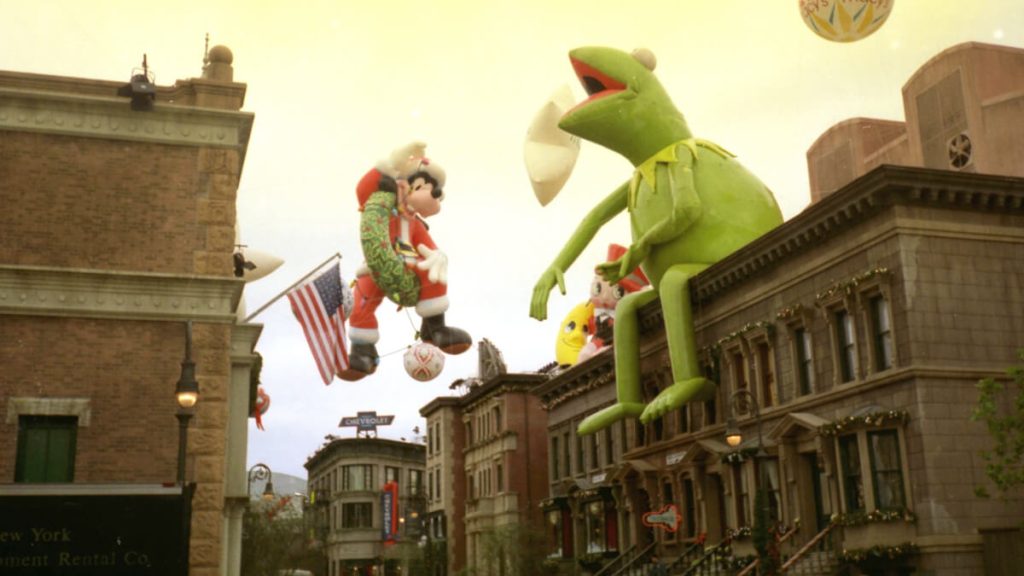
Let’s now look at perhaps the seasonal show which had the shortest run at this WDW theme park. And that’s “Macy’s New York Christmas.”
This all keyed off of the Company looking for ways to … Well, not only to celebrate Goofy’s 60th birthday but also raise awareness for “Goof Troop” (i.e., that then-new animated series which had just joined the “Disney Afternoon” programming block in syndication on September 5th of that same year). Which is why Disney cut a deal with the Macy’s Parade Studio to craft a 65-foot-tall inflatable version of this cartoon character which would be dressed as Santa Claus. Which would then make an appearance in the 66th annual Macy’s Thanksgiving Day Parade. Which would march through the streets of NYC & be televised nationally on November 26, 1992.
As part of Disney’s deal with Macy’s, the Company got the rights to (after the Thanksgiving Day Parade was over, of course) bring that Santa Goofy balloon down to Florida. Where – along with four other balloons which had been featured in that year’s parade (i.e., Kermit the Frog, Betty Boop, Snuggle the fabric softener Bear and Humpty Dumpty) – these inflatables would then tethered to the tops of buildings down in Disney-MGM’s backlot. Which Guests could then view as they strolled through the Streets of America from December 5, 1992 – January 3, 1992.
And given that I’ve been lucky enough to befriend some folks who work in Macy’s Parade Studio, I can now tell you that this idea – keeping 5 of Macy’s Thanksgiving Parade balloons inflated for a full month (rather than for just the few hours it typically takes to pre-inflate these things, then send them aloft in time for their televised trip down Broadway, then get these ginormous balloons un-inflated & packed up for their trip back to Hoboken, NJ. Which is where – until 2011 — the actual physical Parade Studio was located in an old Tootsie Roll factory) – absolutely terrified the folks who worked at Macy’s.
Why? Because those Macy’s Thanksgiving Day parade balloons are rather fragile creatures. More to the point, helium – the gas that’s used to inflate these things – rapidly expands when exposed to heat. So the fear here was keeping these 5 balloons inflated for a full month in the Florida sun was going to eventually leave these things in tatters.
Luckily, Santa Goofy & his pals came through their 29-day-long stint at Disney-MGM unscathed. And while this was a one-and-done seasonal extravaganza as far as the Disney Parks was concerned, Universal just loved this idea. Which is why – starting in 2002 – the Macy’s Holiday Parade (later Universal’s Holiday Parade featuring Macy’s) began seasonally rolling through Universal Studios Florida.
“Aladdin’s Royal Caravan”
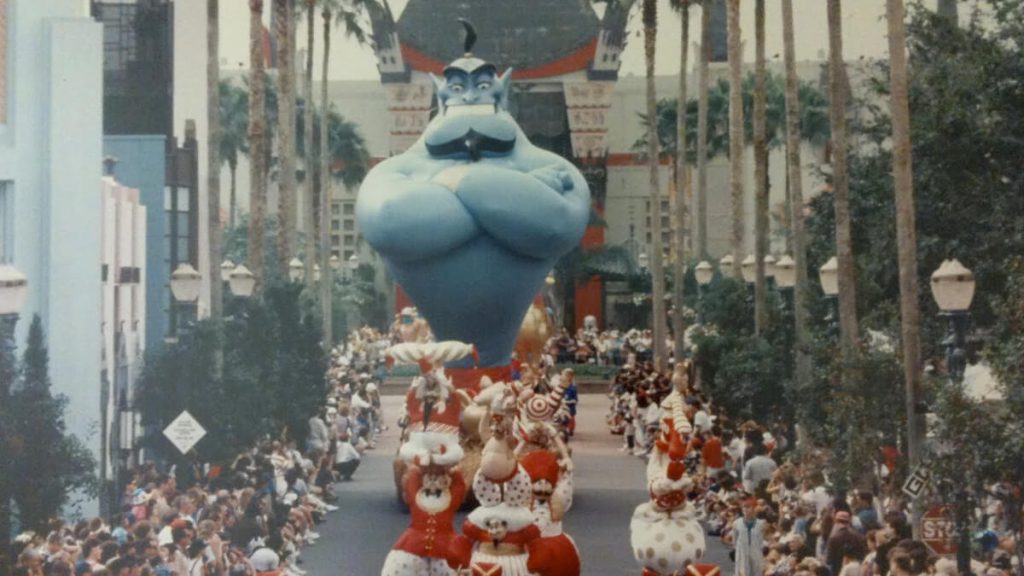
As we continue our look back at rides, shows & attractions that we can no longer see at Disney-MGM (Now Disney’s Hollywood Studios), let’s take a look at “Aladdin’s Royal Caravan,” a hugely popular parade that debuted at this theme park back on December 21, 1992. Which was one month after the animated feature that inspired “Aladdin’s Royal Caravan” first debuted in theaters.
To be honest, WDW Entertainment had never ever done this before. Based a parade for the Parks on a single film. Much less a specific sequence from a Walt Disney Animation Studios production. But the “Prince Ali” number from this Ron Clements / John Musker movie was such a high point from this soon-to-be Oscar-winning film that it felt … Well, almost like a no-brainer to use this Howard Ashman & Alan Menken number as the jumping-off point for “Aladdin’s Royal Caravan.”
Mind you, because Robin Williams’ Genie character appears in so many different disguises in this part of the “Aladdin” movie that WDW Entertainment then felt free to have multiple versions of this character make appearances in “Royal Caravan.” First there was the Drum Major Genie who started off the parade, followed by the 32-foot-tall inflatable version of this character. Directly behind this super-sized Genie was a version of this character in the bathtub. Who was then followed by a Genie who had been split into his upper & lower half.
This five-unit parade – which featured those infamous golden camels (Watch out! They spit!) – may not have been the longest thing to roll through the streets of Disney’s Hollywood Studios. But WDW visitors just loved “Aladdin’s Royal Caravan.” So much so that this WDW Entertainment-designed affair (which was only supposed to run for a year) got its run at this theme park extended through August of 1995.
In fact, “Aladdin’s Royal Caravan” was so popular with folks who visited the Mouse’s theme parks in Florida that then-Disney CEO Michael Eisner decided that Disneyland needed a clone of this parade. This second version of “Aladdin’s Royal Caravan” was then rushed into production and managed to debut in Anaheim by April 2, 1993.
“Ace Ventura: Pet Detective – Live in Action”
“Ace Ventura: Pet Detective – Live in Action” – kind of redefines “short-lived.”
For those of you who don’t remember “Ace Ventura: Pet Detective,” this was a Jim Carrey comedy that was released to theaters back in February of 1994. This Tom Shadyac movie did well enough at the box office that Warner Bros. quickly greenlit a sequel, “Ace Ventura: Pet Detective – When Nature Calls.”
To help promote this sequel (which arrived in theaters on November 5, 1995), Warner Bros. cut a deal with Disney to have a live stunt show featuring the Ace Ventura character presented 5 times daily on Disney-MGM’s “Streets of America.” It was hoped that this stunt show would then help raise awareness of “When Nature Calls” and maybe convince a few visitors to WDW’s third theme park to then go see this “Ace Ventura” sequel at the AMC Pleasure Island (i.e., that movie theater which is now known as the AMC Dine-In Disney Springs 24).
This “Live in Action” stunt show mainly consisted of a Disney cast member dressed as Ace Ventura climbing up & down various facades found on the “Streets of America.” Sometimes Ace would attempt to capture a giant spider that had gotten loose. Other times this Pet Detective would enlist Guests help in finding a rare albino bat (which kids would eventually find hanging from one of these buildings’ fire escape. After shouting a few of the catch-phrases for these Jim Carrey movies (EX: “Do NOT go in there!), Ace would then pose for pictures & sign some autographs.
Though “Ace Ventura: Pet Detective – When Nature Calls” did significantly better at the box office than the first “Ace Ventura” did (i.e., selling $212 million worth of tickets versus the $107 million purchased for the first film), Carrey, Morgan Creek Productions & Warner Bros. opted not to make a third “Ace Ventura” film for theatrical release.
And as for this stunt show, with the start of the New Year in 1996, Disney-MGM quietly pulled the plug on “Ace Ventura: Pet Detective – Live in Action.” Here’s hoping that WDW Entertainment found some good homes for that giant spider & albino bat.
“The Osborne Family Spectacle of Dancing Lights“
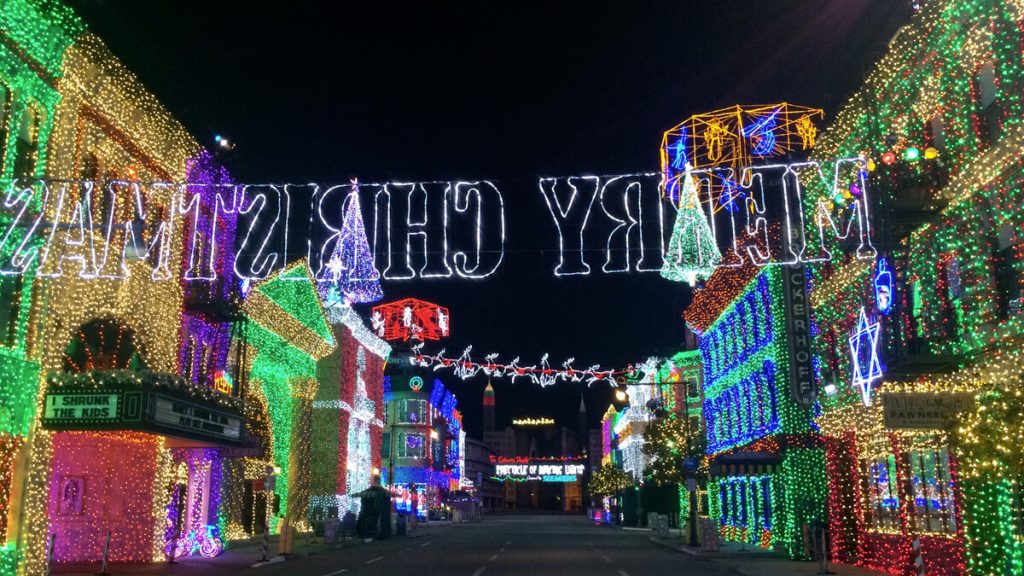
We now arrive at the seasonal attraction that most longtime WDW fans will cite as the thing they miss most of all, the Osborne Family Spectacle of Dancing Lights.
This holiday favorite … Well, it grew out of a request that Breezy Osborne made to her Dad back in 1986. She asked Jennings (a successful Arkansas businessman) if they could please cover their Little Rock home with Christmas lights.
Daddy honored Breezy’s request. And with every passing year, Jennings added even more Christmas lights. Until – by 1993 – the Osborne family home was lit up by more than 3 million bulbs. Which turned this annual holiday display into a genuine tourist attraction in Little Rock. Not to mention really annoying Jenning’s neighbors.
As you might expect, this matter eventually wound up in court. When the Arkansas Supreme Court shut down this seasonal display in 1995, the Entertainment team at Walt Disney World reached out to the Osborne family and offered up Residential Street as a possible new home for those 3 million+ bulbs.
Mind you, it took four full-sized Mayflower moving vans to haul all those Christmas lights from Little Rock down to Orlando. It then took Disney technicians two weeks to untangle those thousands of strings of bulbs. But by November 22, 1995, Residential Street was all lit up. And WDW suddenly found itself with a new seasonal favorite.
Over time (and to better handle the crowds that came out every year to see this holiday display), the Osborne Family Spectacle of Dancing Lights eventually moved from Residential Street over to the Streets of America. And that’s where they stayed until WDW finally decided to pull the plug on this Christmas tradition on January 3, 2016 so that DHS’ backlot area could then be torn down. Which would then allow construction of the Florida version of “Star Wars: Galaxy’s Edge” to get underway.
Just so you know: Every so often, WDW officials revisit the idea of reviving the Osborne Family Spectacle of Dancing Lights. There’s even been talk of building an entire faux neighborhood on property so that people could then drive through every holiday season and view this Christmas display just as Breezy & Jennings originally intended. But to date, The Walt Disney Company has yet to put that plan in motion.
“Toy Story Parade”
I’d like to now offer up a story about one of my personal favorite, which was the Toy Story Parade.
I was living down in Orlando when this parade originally debuted at WDW’s third theme park. Not only that, but the day that the “Toy Story Parade” debuted at Disney-MGM (i.e., November 22, 1995) … Well, I started my morning over at the AMC Pleasure Island. Where I caught the very first screening of “Toy Story,” Pixar’s first full-length animated feature.
That screening began at 11 a.m. Given that this John Lasseter film was only one hour and 17 minutes long, I was able to walk out of that screening of “Toy Story,” climb into my trusty Geo Metro and then drive over to Disney-MGM. Where I was then able to gain entrance to that theme park just in time to catch the very first presentation of the “Toy Story Parade.” Which stepped off at 1 p.m. at Crossroads of the World and then rolled up Hollywood Boulevard.
Given that Disney had never done this before (i.e., have a parade that keyed off of a specific film debut at one of the Company’s theme parks day & date with that very same movie’s arrival in theaters), I have to tell you that it was genuinely surreal to see the “Toy Story” characters
And I have to tell you it was genuinely surreal to see all of these Pixar character suddenly writ large. The “Toy Story Parade” started off with the Green Army Men manning the marquee float. Next came Hamm & Mr. Potato on top of a pile of over-sized board games. After that came Buzz atop of his “Star Command” box surrounded by Little Green Aliens. Bringing up the rear was Woody & Rex. And inbetween these four floats were walk-around versions of Bo Peep & Slinky Dog. Not to mention a Barrel O’ Monkeys.
One especially strong memory of that day was the woman who was standing next to me as the “Toy Story Parade” made its inaugural trip through Disney-MGM. And all she kept saying was “Where’s Mickey? I don’t know who any of these characters are.” And as soon as all those floats & performers cleared Crossroads of the World, this woman marched straight into Guest Relations and then complained loudly about how … Well, a parade at a Disney park should feature Disney characters. Not these weird Pixar characters from some movie that no one’s ever seen.
Mind you, everyone knows who Buzz & Woody are now. And what with “Toy Story 5” already in the works … Who knows? Maybe Disney’s Hollywood Studios will host an all-new “Toy Story Parade” in the not-too-distant future
“Backlot Theater”
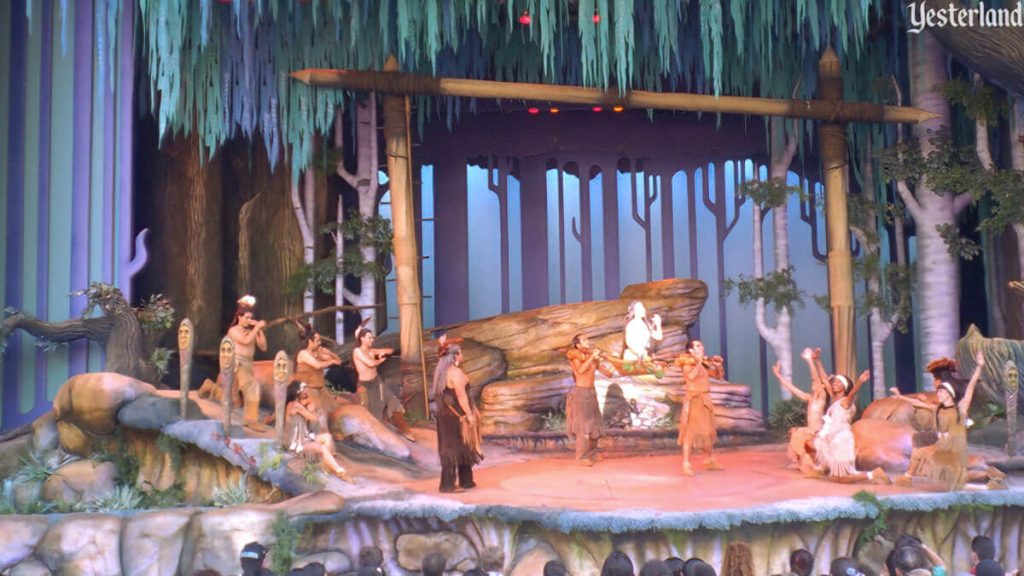
As we continue our look back at rides, shows & attractions that used to be up & running at Disney-MGM (now Disney’s Hollywood Studios), how many of you recall the Backlot Theater?
This immense performance venue (it had seating for 1500 Guests) originally came online on May 23, 1993 (30 years ago this week). The Backlot Theater was built as a replacement for the Theater of the Stars, that inspired-by-the-Hollywood-Bowl complex that used to be located just off of Hollywood Bowl at this theme park.
The two live stage shows that most Guests saw in the Backlot Theater keyed off of two animated features that Disney released in the mid-1990s. First came “The Spirit of Pocahontas,” a stage version of this Academy Award-winning film. This 28-minute-long retelling of Disney’s “Pocahontas” movie (which – FYI – began presenting performances at Disney-MGM on the exact same day that the animated feature version of this film first opened in theaters. Which was June 23, 1995) featured a 28-foot-tall version of Grandmother Willow. Not to mention a cast of 30 singers & dancers.
“The Spirit of Pocahontas” had a relatively short run at WDW’s third theme park. This stage show closed on February 24, 1996 to make way for an even more elaborate production. Which was “Hunchback of Notre Dame: A Musical Adventure.”
Just like with “The Spirit of Pocahontas,” the “Hunchback of Notre Dame: A Musical Adventure” was a stage version of Walt Disney Animation Studios’ most recent (at that time, anyway) theatrical release. It opened on June 21, 1996 (again the very same day that the animated “Hunchback” opened in movie theaters nationwide) and then settled in for a good long run. The very last presentation of “Hunchback of Notre Dame: A Musical Adventure” wouldn’t happen ‘til over 6 years later. On September 28, 2002 to be exact.
FYI: If you have memories of sweating through performances of “The Spirit of Pocahontas” and/or “The Hunchback of Notre Dame: A Musical Adventure,” there’s a reason for that. The Backlot Theater was an open-air theater. The stage itself was undercover, which protected the actors from that changeable Central Florida weather. But not the audience.
Mind you, once the “Hunchback” stage show ended in its run in 2002, the Imagineers transformed this Streets of America area performance venue into a totally enclosed theater with air conditioning. It would then be redubbed the Premier Theater and eventually become home to the first iteration of the “For the First Time in Forever: Frozen Sing-along” show.
“Super Soap Weekend”
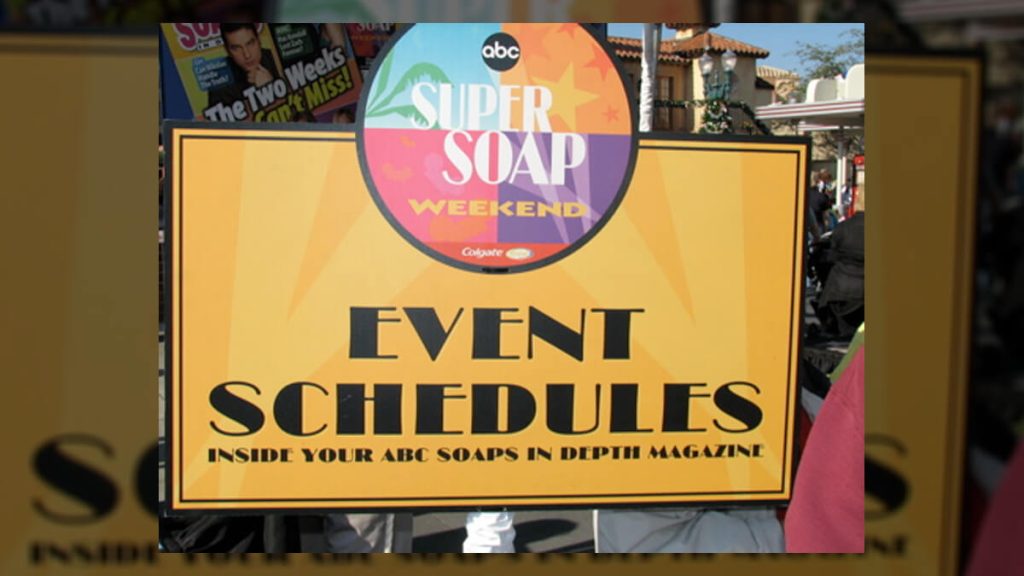
Let’s take a look at one of the more popular fan events to ever be presented at this theme park. And that’s Super Soap Weekend.
This event actually dates back to August of 1995. Which is when The Walt Disney Company announced that it would be acquiring ABC / Cap Cities for $19 billion (That’s $37 billion in 2023 dollars).
Mind you, then-Disney CEO Michael Eisner actually started his career at the Alphabet network. He quickly rose through the ranks. And – by 1971 – Michael was the vice president of daytime programming at ABC. Which meant that Eisner helped get two of that television network’s long running soap operas – “One Life to Live” & “All My Children” – up out of the ground.
So is it any wonder that – after The Walt Disney Company completed its acquisition of ABC / Cap Cities in February of 1996 — one of the very first things that Michael Eisner did was order that Disney-MGM stage an in-park event that then celebrated the Alphabet Network’s daytime dramas.
And just eight months later (On October 19 – 20th, to be exact), the very first Super Soap Weekend was staged at WDW’s third theme park. And while Disney had hoped this event would be popular, they were stunned when people began lining up outside MGM’s gates at 3 a.m. Just so they could then be sure to get the autograph of their favorite soap star.
Since Nancy was (and still is) a huge ABC Daytime fan, she & I attended all but one of the Super Soap Weekends. And when I say that I “attended,” what I mean is that I got Nancy to Disney-MGM first thing in the morning and then collected her late at night after that day’s festivities had wrapped.
Sadly, Disney-MGM staged its last Super Soap Weekend in November of 2008. But we still have a pile of those black & white 5 & 7s that ABC gave away for free of Nancy’s favorite daytime performers. She still looks back on those times with much fondness.
“Star Wars Weekends”
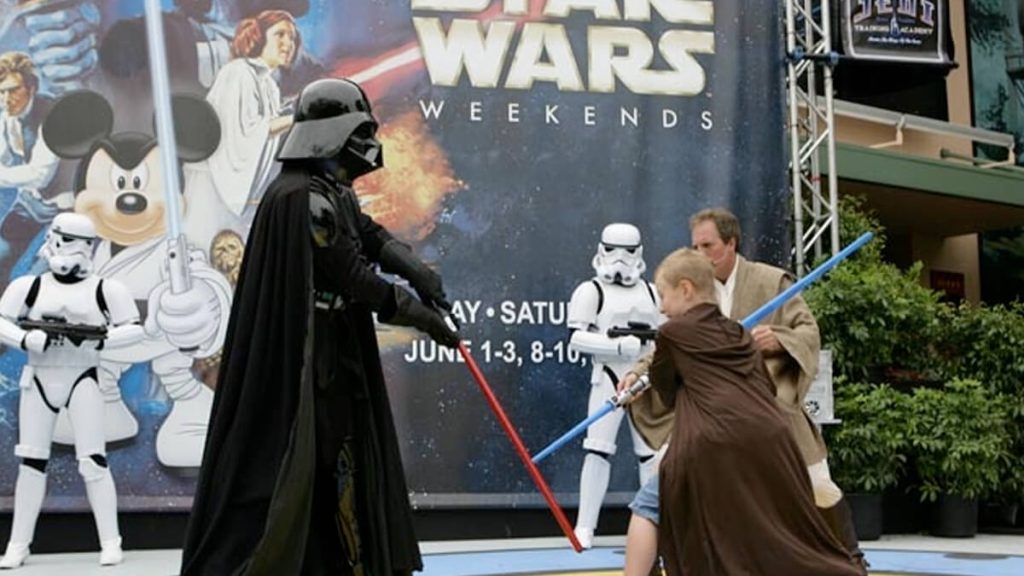
As we continue our look back at long-gone rides, shows & attractions at Disney-MGM (Now Disney’s Hollywood Studios), let’s talk about an annual event that eventually led to a whole new land at this theme park. And that’s Star Wars Weekends.
It was an outside event that actually made the Mouse decide to take a flyer on this four / sometimes five weekend-long event. And that was George Lucas’ decision to release the Special Editions of the original Star Wars trilogy. When “A New Hope” opening in theaters on January 31, 1997, then “The Empire Strikes Back” following Episode 4 into your local multiplex just three weeks later on February 21st.
In fact, the Special Editions of Episode 4 & 5 did so well at the box office that Lucas (along with 20th Century Fox) opted to push back the release date of the Special Edition of “Return of the Jedi” by a full week (from March 7, 1997 to March 14th of that same year). Just so “The Empire Strikes Back” would then have even more time to sell tickets to Star Wars fans.
And when Disney Parks learned in 1996 that George Lucas was readying the “Special Editions” for theatrical release in the first quarter of 1997 … Well, they saw an opportunity to piggyback on all of the promotion that Lucas & 20th Century Fox would obviously be doing in order to convince moviegoers that they really needed to see these spruced-up version of “A New Hope,” “The Empire Strikes Back” and “Return of the Jedi.”
Which is why they scheduled their own month-long Star Wars-related event to kick off on Friday, February 21st. Which was just as the Special Edition of “The Empire Strikes Back” was arriving in theaters. Using Disney-MGM’s “Star Tours” (Not to mention the full-sized Imperial Walker & Ewok Village that the Imagineers built just outside the entrance of this motion-based simulator attraction) as the center pole for this 5-week-long event … Well, they invited the stars of the original Star Wars trilogy (We’re talking people like …
- David Prowse AKA Darth Vader
- Kenny Baker AKA R2D2
- Anthony Daniels AKA C3P0
- Peter Mayhew AKA Chewbacca
- Jeremy Bullock AKA Boba Fett
- And Warwick Davis AKA Wicket the Ewok)
… to take part in daily motorcades, not to mention meet-n-greets and autograph sessions with Star Wars fans.
The first Star Wars Weekends (which ends on March 23, 1997. Which as just as the Special Edition of “The Return of the Jedi” was ending its theatrical run) was so hugely successful that – when “The Phantom Menace” premiered in theaters in May of 1999 and did boffo box office – the Mouse announced that Star Wars Weekends would be returning to Disney-MGM.
As it did (with a year off in 2002) for the next 15 years. Disney’s Hollywood Studios only discontinued Star Wars Weekends after the 2015 edition so that work could then begin on this theme park’s “Star Wars: Galaxy’s Edge” land.
“Goosebumps HorrorLand Fright Show”
Let’s talk about another really short-live show at this theme park. Which was the Goosebumps HorrorLand Fright Show.
Now when it came to the original iteration of Disney-MGM Studios, the Imagineers always knew that this theme park came up short when it came to one particular film genre. And that was horror.
Oh, sure. There was Disney-MGM’s “Monster Sound Show” (but that wasn’t really about horror. But – rather – how sound effects are added to films in post-production). Likewise the mummy’s tomb scene in “The Great Movie Ride” (but that wasn’t really about horror either. It was mostly an extension of that ride-thru attraction’s “Raiders of the Lost Ark” sequence).
Mind you, the Imagineers developed a few horror-themed attractions for Disney-MGM. There was Soundstage 13, which was supposed to be home to this theme park’s “Hotel Mel” ride (Believe it or not, Mel Brooks was actually supposed to be the host of this ride-thru show that spoofed horror. Which – over time – mutated in this theme park’s signature attraction, “The Twilight Zone Tower of Terror”). There was also the “Creatures Choice Awards,” which was supposed to mix Hollywood’s love of awards shows in with a salute to the horror genre. And this show – if it had ever built – was supposed to climax with Godzilla literally bringing down the house as he arrived to accept his Lifetime Achievement Award.
But because the Disney Parks like to be considered family-friendly … Well, it wasn’t ‘til R.L. Stines’ best-selling series of scary tales for young adults (not to mention the “Goosebumps” TV series that spun off from that set of books) came along in the mid-1990s that the Imagineers thought they finally had a horror-themed property that would then work for Disney-MGM Studio theme park.
So the Goosebumps HorrorLand Fright Show was built towards the back of the Streets of America (kind of where the Teenage Mutant Ninja Turtle stage show / meet-n-greet had been located at this same theme park back in the late 1980s). It opened in early October of 1997 (just in time for Halloween) and featured popular Goosebumps characters like Slappy the ventriloquist doll, Prince Khor-Ru the Mummy, Curly the Skeleton and Cuddles the Giant Hamster.
Mind you, the Mouse had to pay R.L. Stine (not to mention the producers of the “Goosebumps” television series) for the rights to use these characters in a theme park setting. And when the “Goosebumps HorrorLand Fright Show” didn’t prove to be as popular with visitors to Disney-MGM as the Company had originally hoped … Well, they opted not to renew this deal.
Which is why – after one last Halloween presentation – the “Goosebumps Horrorland Fright Show” closed on November 1, 1998.
was an attraction at Disney’s MGM Studios in Walt Disney World and ran from October 8, 1997, to November 1, 1. 998.
“Doug Live!”
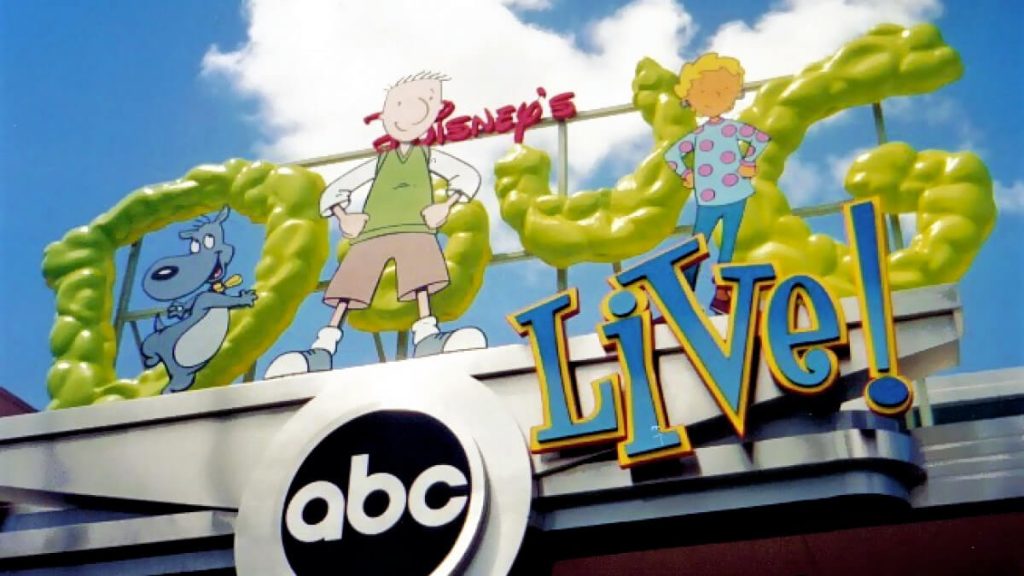
It’s now time to talk about “Doug Live!,” the short-lived musical based on that Emmy-nominated animated series.
This show arrived at Disney-MGM in kind of a convoluted way. By the Spring of 1998, “Superstar Television” (which was an opening day attraction at this theme park) was showing its age. WDW’s Entertainment team had tried to freshen up this celebration of network TV by folding in new vignettes that were pulled from recent Touchstone Television-produced hits like “Home Improvement” & “Empty Nest.” But in the end (largely because return visitors to Disney-MGM were now regularly passing this audience participation show by), they knew it was now time to develop a “Superstar Television” replacement.
On a parallel track, in 1996, Disney acquired Jumbo Studios (i.e., the animation production company that made “Doug.” Which was that popular animated series which debuted on Nickelodeon back in August of 1991). As a direct result of this acquisition, the Mouse now had the rights to produce three additional seasons of “Doug.” Which – to differentiate this new set of shows from the ones that Jumbo had originally produced for Nickelodeon – would now be rebranded as Disney’s “Doug.”
And since Disney prides itself on being a synergy machine (And also because there was a belief out there in the mid-to-late 1990s that Disney-MGM didn’t have enough stuff that appealed to pre-teens), a “Doug” musical was put in development for this theme park. The goal going into this project was to create a show that could be presented at least 5 times a day. Getting as many Guests as possible in & out of this 1000-seat venue over the course of a typical operating day.
To be honest, “Doug Live!” didn’t live all that long. This musical was presented inside of Disney-MGM’s old “Superstar Television” from September 26, 1998 through May 12, 1999. So this show only got an eight month-long run.
That said, fans of the “Doug” TV shows (both the four seasons that ran on Nickelodeon AND the three seasons produced by Disney. Not to mention “Doug’s 1st Movie,” which was released theatrically in March of 1999) still talk about the great job that the human performer who played Porkchop (That’s Doug’s dog) did in this stage show.
“ABC Sound Studio: Sounds Dangerous!”

Let’s now talk about all of the auditory excitement that Guests got to experience whenever they dropped by this theme park’s ABC Sound Studio. Which is where the “Sounds Dangerous!” show was presented.
Of course, this Echo Lake-adjacent complex used to be home to Disney-MGM’s “Monster Sound Show.” But when attendance began dropping for this opening day attraction in the mid-1990s … Well, WDW first tried to turn this situation around by launching a new show in this space back in July of 1997 that was deliberately aimed at a pre-teen audience.
Unfortunately, the “One Saturday Morning” show (which keyed off of how ABC promoted its Saturday morning line-up back in the mid-to-late 1990s) didn’t appeal to adults. Which is why WDW Entertainment halted this presentation after just 19 months and then turned to Drew Carey for help.
At that time, Carey was the star of two hit shows on ABC (i.e., “The Drew Carey Show” and “Whose Line is it Anyway”). More to the point, Drew just loved the Disney theme parks. So much so that — when he wasn’t busy taping his two shows for the Alphabet Network — Carey could often be found at Disney’s Grand Floridian Resort & Spa.
Anyway … In late 1998, the Imagineers reached to Drew and said “We were thinking about building an attraction for the Parks around you.” And as the story goes, Carey said “Yes!” before the folks at 1401 Flower Street could even explain to him what this new show for Disney-MGM was supposed to be about.
“Sounds Dangerous!” made use of that binaural technology which used to be showcased in the post-show portion of “The Monster Sound Show.” How many of you remember taking a seat in one of those darkened booths, putting on a set of headphones and then getting a haircut in 3D sound?
The Drew Carey version of this 3D sound show involved sitting in a dark theater for 12 minutes and then getting menaced by scary sounding things like stampeding elephants & killer bees. Which (I’ll admit) doesn’t sound like much fun. But Carey’s likability as a performer coupled with the Imagineers’ ingenuous of binaural technology made “Sounds Dangerous!” a fun way to spend part of your day at Disney-MGM.
This revamped attraction was a regular offering at this theme park through early 2009. After that point, “Sounds Dangerous!” then became a seasonal offering at Disney-MGM (which meant that it was only open to Guests when this theme parks was at its absolute busiest and then needed the additional capacity). By May of 2011, this starring-Drew-Carey show closed for good. Only to then be replaced in November of 2015 by “Star Wars: The Path of the Jedi.”
“Bear in the Big Blue House: Live on Stage”
Let’s take a look at an interactive stage show that parents with preschoolers used to flock to. And that’s “Bear in the Big Blue House: Live on Stage.”
The inspiration for this theme park attraction was – of course – the “Bear in the Big Blue House” TV series. That show debuted as part of the Disney Channel’s Playhouse Disney programming block back in October of 1997. And this Shadow Projects / Jim Henson Television co-production was so popular that four seasons of this Emmy Award-winning series were eventually produced.
And Disney being Disney … Well, when you have a successful TV show, you then immediately look for ways to bring that IP into your theme park which celebrates film & television. Which is – of course – Disney’s Hollywood Studios.
Now where this gets interesting is how Disney decided to bring “Bear in the Big Blue House” into WDW’s third theme park. Given that – if the Park opted to build a brand-new structure to house this stage show – it would have been a year or more before toddlers finally got the chance to hang out with Bear, Tutter, Ojo & Treelo. And who knew if this TV program would even still be popular with preschoolers by then?
This is why – in order to fast-track this project – managers at Disney-MGM opted to shut down that theme park’s Soundstage Restaurant on November 14, 1998. They then transformed the dining area of this breakfast buffet / quick service venue into a performance space. Which then threw open its doors just seven months later on June 7, 1999.
What WDW managers especially loved about “Bear in the Big Blue House: Live on Stage” was … Well, because preschoolers’ attention spans are short, they were then allowed to keep the running time of this interactive stage show extremely short as well. We’re talking just a 15 minute-long run time. Which meant that this theme park could then load a brand-new audience into Soundstage 5 every 30 minutes.
And when that 7-foot-tall bear came out onstage, those toddlers would react like they were in the presence of Elvis. They’d scream. They’d cry. They’d clap.
Mind you, to broaden the appeal of this Disney-MGM offering, “Bear in the Blue House: Live on Stage” was shut down in August of 2001 for retooling. Some two months later, “Playhouse Disney – Live on Stage!” debuted inside of Soundstage 5. And in addition to Bear, this now-20 minute-long interactive experience featured appearances by characters from other popular Disney Junior shows like “Rolie Polie Olie,” “Stanley” and “The Book of Pooh.”
FYI: The “Bear in the Big Blue House” TV series became available for streaming on Disney+ in October of last year. And there has been a lot of talk lately about the Company possibly reviving this hugely popular program for preschoolers. So stay tuned.
“Sorcerer’s Hat”

We’re in the home stretch now in regards to rides, shows & attractions at Disney-MGM (now Disney’s Hollywood Studios) that are no longer with us. And perhaps the most controversial item to ever be built at this theme park had to be the Sorcerer’s Hat. Which was that 122-foot-tall structure built at the top of Hollywood Boulevard in front of the Chinese Theater.
Mind you, that’s not where the Imagineers originally wanted to this structure to be built. The thinking – early on, anyway – was that the Sorcerer’s Hat should be built down by Disney-MGM’s entrance. To be specific, just off to the right of where Guests enter this theme park after they get off the boat from Epcot.
What’s more, WDI’s original design for the Sorcerer’s Hat (which was supposed to be the focal point of Walt Disney World’s “100 Years of Magic” celebration in 2001) was so much larger. So large in fact that the Mickey ears which jutted out to either side of this super-sized conical wizard’s cap were supposed to have been a pair of full-sized Ferris Wheels that Guests could have then ridden. Not only that, but the rectangular building which was to have served as the base of this fanciful structure … Well, that’s where the “Walt Disney: One Man’s Dream” exhibit was originally supposed to be housed.
Unfortunately, as time went by, the Company’s plan for WDW’s 15-month-long “100 Years of Magic” celebration got far less ambitious and far more economical. This is why – instead of building a brand-new structure to house “Walt Disney: One Man’s Dream” out towards the main entrance to this theme park – that Disneyana exhibition eventually got shoehorned into the old Post-Production portion of Disney-MGM’s backstage walking tour.
And as for the Sorcerer’s Hat … This 156-ton structure then became part of the hot new fad that WDW Resort was really leaning into at that time. Which was pin trading. This is why that 60,000 square foot space at the base of the Hat got turned into a pin shop.
The Sorcerer’s Hat opened on October 1, 2001. And for the next 13+ years, it blocked Guests’ view of the Chinese Theater. Thankfully, on January 7, 2015, demolition of the Hat began. And by February 25th of that same year, the 91 panels that made up this structure were all cleared away. Which was quite the hat trick.
“Disney Stars and Motor Cars Parade”
Let’s take a look at a parade that rolled through this theme park for over 6 years in the early 2000s. And that’s “Disney Stars and Motor Cars.”
In the early, early days of Disney-MGM (we’re talking the late 1980s / early 1990s here), there was a daily “Star of the Day” motorcade at this theme park. Some veteran of film or television would first climb into the back of a convertible and roll up Hollywood Boulevard as they waved to the Guests gathered on the sidewalk. After that, this celebrity would then take part in a handprint ceremony out in front of the Chinese Theater.
WDW Entertainment remembered how popular that daily motorcade had been with visitors to Disney-MGM. Which is why – when the Company was readying a year-long celebration of Walt Disney’s birth (i.e., That resort’s “100 Years of Magic” celebration. Which kicked off on October 1, 2001) – these folks wondered: Could we maybe replicate that event? Only instead of having some aging actor in a convertible roll up Hollywood Boulevard, how about we create a daily motorcade for the Studios that then treats the Disney & Pixar characters like the stars that they are?
And that was the jumping-off point for the development of “Disney Stars and Motor Cars Parade.” With the basic idea here being mixing classic Hollywood (which is why all of the vehicles that the characters ride in were deliberately crafted to look vintage) with Disney & Pixar’s latest & greatest. In fact, right from the get-go, that was one of the main creative conceits of this new daily parade at Disney-MGM. That the grand marshall of that day’s presentation of “Disney Stars & Motor Cars” would always be the lead character of whatever Disney or Pixar film just happened to be out in theaters at that same time.
Which is why – over the six+ year run of “Disney Stars & Motor Cars” – Guests got to see Chicken Little, Remy from “Ratatouille” & Giselle from “Enchanted” – serve as this parade’s grand marshall.
Anyway … This parade concept proved to be so sturdy / so popular with Guests that, after “Disney Stars & Motor Cars” ended its run in Florida, this parade was then packed up & shipped off to France. Where – in April of 2009 – it then began rolling through Disney-MGM’s sister park. Which is Walt Disney Studios Park in Paris.
Which begs the question: When “Disney Stars and Motor Cars” made its Parisian debut, was it now just a rolling used car lot?
“American Idol Experience”
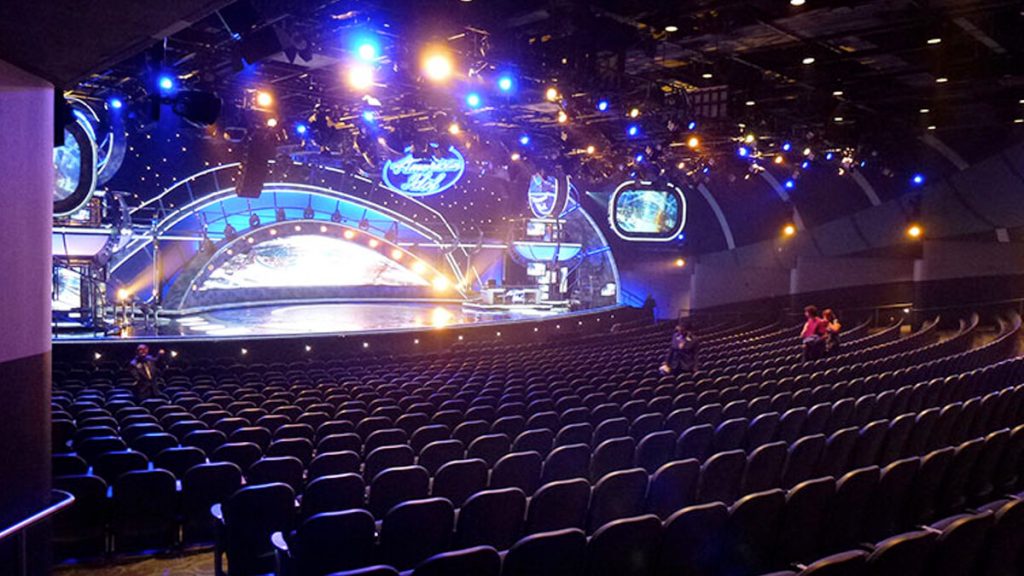
There’s only a handful of stories left to share in this series about now-defunct rides, shows & attractions at Disney-MGM (Now Disney’s Hollywood Studios). So now let’s talk about a show that – to be blunt – was kind of snake-bit during its 5-year-long run at this theme park. And that’s the “American Idol Experience.”
Okay. To understand how Disney-MGM wound up with an “American Idol” -themed show, we first have to talk about “American Idol,” the TV show. Which debuted on Fox in June of 2002 and quickly became this white-hot phenomenon.
Meanwhile, at Disney-MGM, the Imagineers were genuinely struggling when it came to fill that theme park’s 1000-seat “Superstar Television” theater. We’ve talked previously in this series about one show that was staged in this space. And that was “Doug Live!,” the 30 minute-long musical which ran in this theater from March of 1999 – May of 2001. Then there was the “Get Happy … with ABC” show, which debuted in this space on July 1, 2002 and was then gone by October 5th of that same year.
The theater that previously housed “Superstar Television” then stood empty for more than 5 years until – in February of 2008 – it was revealed that a live performance attraction based on the then-hugely popular Fox reality series would open at Disney-MGM in just one year’s time.
Ah, but what no one at the Mouse House foresaw was – over the next 364 days – “American Idol” ‘s formerly stellar ratings on Fox would then begin to slip. So by the time the “American Idol Experience” opened at Disney-MGM on February 14, 2009, this brand-new attraction at that theme park was now based on a show that was rapidly losing its previously devoted audience.
So few people attended performances of the “American Idol Experience” that – by June of 2014 – WDW managers suddenly announced that this audience participation show would be shuttering in early January of 2015. Later that same Summer, things got so dire at Disney-MGM that this theme park actually pushed forward the closing of this attraction by a full 5 months and then pulled the plug on the place on August 30, 2014.
What was especially galling to the Imagineers is that – just prior to the opening of Disney-MGM’s “American Idol Experience” back in 2009 — they had spent millions overhauling the interior of the “Superstar Television” theater so that it then looked exactly like the set of this Fox TV show. Only to have this expensive-to-mount show barely eek out a 5-year-long run. But the upside is … The very next show to be staged in this space (i.e., “For the First Time in Forever: A Frozen Sing-Along Celebration,” which opened in the now-renamed Hyperion Theater on June 17, 2015) has proven to be hugely popular with Guests. Barring a seven month-long shutdown in 2020 due to the pandemic, this show has been presented continuously in this theater – sometimes as often as 10 times a day.
“Journey Into Narnia: Creating The Lion, The Witch and The Wardrobe”
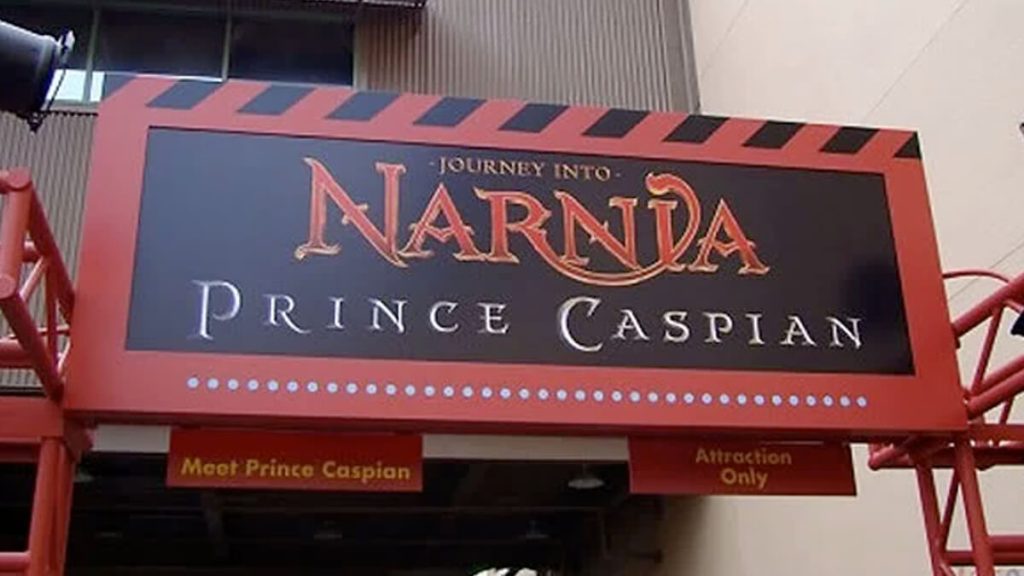
It’s now time to discuss Disney’s attempt to launch a “Chronicles of Narnia” film series. Which then lead to two attractions at DHS.
If we’re being completely honest here, it was the success of the first two “Harry Potter” movies (i.e., 2001’s “The Sorcerer’s Stone” and 2002’s “Chamber of Secrets”) that spurred executives at the Mouse House to seek out another book series which featured magic that could then be turned into a film franchise.
With this idea in mind, Disney announced in March of 2004 that it would be partnering with Walden Media to produce “The Chronicles of Narnia.” This series of live-action adaptations of C.S. Lewis’ fantasy novels would kick off with “The Lion, the Witch, and the Wardrobe.” Which would arrive in theaters just in time for the 2005 holiday season.
And – of course (because the Mouse prides itself on synergy) – Disney’s Hollywood Studios would help promote this just-getting-underway film series. Which is why – on December 9, 2005 (i.e., the very same day that Disney’s “The Lion, the Witch, and the Wardrobe” first opened in theaters – “Journey into Narnia: Creating The Lion, the Witch, and the Wardrobe” threw open its doors at this theme park.
This walk-thru exhibit (which was set up inside of Soundstage Four) started with Guests stepping through a super-sized wardrobe. Once inside, people found themselves wandering around a frosty (You can thank Disney-MGM’s cooling plant for that), snow-filled forest. Where – after watching a few clips from this Andrew Adamson movie and then being addressed by a cast member dressed as the White Witch – Guests were then funneled in a second part of this building. Which is where props & costumes from the “Lion, the Witch, and the Wardrobe” movie were displayed.
The first “Chronicles of Narnia” film did well enough at the box office that Disney & Walden Media produced a sequel (i.e., “Prince Caspian,” which arrived in theaters in May of 2008). Disney-MGM used that movie as an excuse to update its “Lion, the Witch and the Wardrobe” walk-thru with props & costumes from the second film in the “Chronicles” series.
Unfortunately, “Prince Caspian” seriously under-performed. So much so that Disney opted out of making a third “Chronicles of Narnia” movie with Walden Media. That said, Disney’s Hollywood Studios let its “Prince Caspian” walk-thru limp along ‘til September 10, 2011. That’s when Soundstage 4 was transformed into the attraction which we’ll talk about tomorrow.
“The Legend of Captain Jack Sparrow”
We now officially bring our look back at long-gone rides, shows & attractions at Disney-MGM (now Disney’s Hollywood Studios) to a close by talking about one of the more misbegotten things to ever be foisted on the theme park going public. And that’s “The Legend of Captain Jack Sparrow.”
Now you have to understand that – when this 13-minute-long show opened inside of Soundstage 4 – it had been a year and a half since the last “Pirates” movie (i.e., “On Stranger Tides”) had opened in theaters. So this project wasn’t done to help promote that movie. But – rather – to help keep this film franchise front-of-mind with WDW visitors until the Studios finally got around to making “Pirates 5.” Which wouldn’t happen for another six years.
Now where this gets weird is that – in spite of the fact that Disney’s “Pirates of the Caribbean” movies were filled with exciting action scenes and sometimes bawdy humor – “The Legend of Captain Jack Sparrow” was written to appeal to a very young audience. We’re talking 5 & 6-year-olds, tops. Which is why there was a talking skull in this show that kept encouraging audience members to do things like roar back at the Kraken and stomp their feet (which then scared away a menacing mermaid). Not to mention periodically scream “Arr!”
Mind you, Imagineering persuaded Johnny Depp himself to come back and play Captain Jack Sparrow in this short-lived show. He was inserted into the proceedings through the use of hi-def digital projection. It was a fun moment in the show. But (if we’re being completely honest here) not enough to redeem “The Legend of Captain Jack Sparrow.”
Given how many adult Guests complained about this “Pirates of the Caribbean” show being mostly for little kids, DHS managers quickly realized that they had seriously miscalculated with “The Legend of Jack Sparrow.” Which is why it was shuttered in early November of 2014, less than two years after this “Pirates”-for-pre-schoolers show had first opened.
And what went next into Soundstage 4? Nothing. This entire structure at the Studios was torn down so that WDI could then create an entrance for an entirely new land for DHS. Which was “Toy Story Land.” Which opened at this theme park in late June of 2018.
-

 History10 months ago
History10 months agoThe Evolution and History of Mickey’s ToonTown
-

 History11 months ago
History11 months agoFrom Birthday Wishes to Toontown Dreams: How Toontown Came to Be
-

 Film & Movies8 months ago
Film & Movies8 months agoHow Disney’s “Bambi” led to the creation of Smokey Bear
-

 News & Press Releases10 months ago
News & Press Releases10 months agoNew Updates and Exclusive Content from Jim Hill Media: Disney, Universal, and More
-

 Merchandise8 months ago
Merchandise8 months agoIntroducing “I Want That Too” – The Ultimate Disney Merchandise Podcast
-

 Theme Parks & Themed Entertainment3 months ago
Theme Parks & Themed Entertainment3 months agoDisney’s Forgotten Halloween Event: The Original Little Monsters on Main Street
-

 Film & Movies3 months ago
Film & Movies3 months agoHow “An American Tail” Led to Disney’s “Hocus Pocus”
-

 Theme Parks & Themed Entertainment3 months ago
Theme Parks & Themed Entertainment3 months agoThe Story of Mickey’s Not-So-Scary Halloween Party: From One Night to a Halloween Family Tradition





